Are you considering adding purple flowers to your garden, but you’re not sure which ones to choose?
The good news is that there are tonnes of purple flowers you can put in your garden! Depending on where you live or the hardiness zone, there are annuals, perennials, and plants in between.
With names and images for each, we examine our top purple flowers for planting this season in this comprehensive guide!
1. Bell Heather
 Scientific Name: Erica Cinerea
Scientific Name: Erica Cinerea
Plant Type: Perennial
Plant Size: About 20 inches tall
Sun Exposure: Full sun
Plant Zone: 6-8
Geographic Origin: England, Scotland
The purple flowers of the Erica cinerea heather cultivar set it apart. The flowers of other heather species are typically rose-coloured.
The purple blossoms, borne on a single, twig-like stem with several spiky prominences, appear strongly in late spring and last until early autumn. A plant can very rarely produce white blossoms.
Bell Heather, also called Twisted Heath, has been used since the Middle Ages as a cure for several illnesses, including gout, arthritis, sore throats, muscle aches, and coughs.
2. Blazing Stars
 Scientific Name: Liatris
Scientific Name: Liatris
Plant Type: Perennial
Plant Size: 8 inches
Sun Exposure: Part sun to full sun
Plant Zone: 3-9
Geographic Origin: Eastern United States of America
Blazing stars come in various kinds, but they always appreciate areas that resemble meadows and have damp soil. Their foliage is grassy, and on top of certain types’ tall stalks are purple blooms.
The tubular, spiked blooms contain seven to twenty-ray petals grouped in spikes that can reach a length of one foot. The best purple flower varieties are Kobold and Floristan Violet.
3. Bougainvillea
 Scientific Name: Bougainvillea glabra
Scientific Name: Bougainvillea glabra
Plant Type: Perennial
Plant Size: Up to 15 feet tall
Sun Exposure: Full sun
Plant Zone: 9-11
Geographic Origin: Brazil and Peru
The most consistently purple kind of bougainvillea is the glabra cultivar. Though some variance is to be expected, the leaves are frequently purple, even though the flowers themselves aren’t always purple.
Pollinators find all varieties of bougainvillaea appealing, and most of them enjoy climbing, arching, and cascading over walls and fences.
Once established, they grow swiftly, feature protecting thorns throughout the stems, and require little upkeep.
4. Butterfly Bush
 Scientific Name: Buddleja davidii
Scientific Name: Buddleja davidii
Plant Type: Annual/Perennial
Plant Size: 2-16 feet tall
Sun Exposure: Full sun to partial shade
Plant Zone: 5-9
Geographic Origin: Tibet to South Central China
Deciduous shrubs are what butterfly bushes are. They bear enormous, conical blooms. The blossoms of this particular cultivar have a purple tint with hints of pink and white.
In certain parts of the world, they are regarded as weeds and can produce orange blossoms. The stalk often droops due to the weight and size of the enormous, pendulous flower heads.
These plants require very little care, and their abundantly nectar-rich cone-shaped flowers attract a lot of insects and butterflies.
5. Canterbury Bells
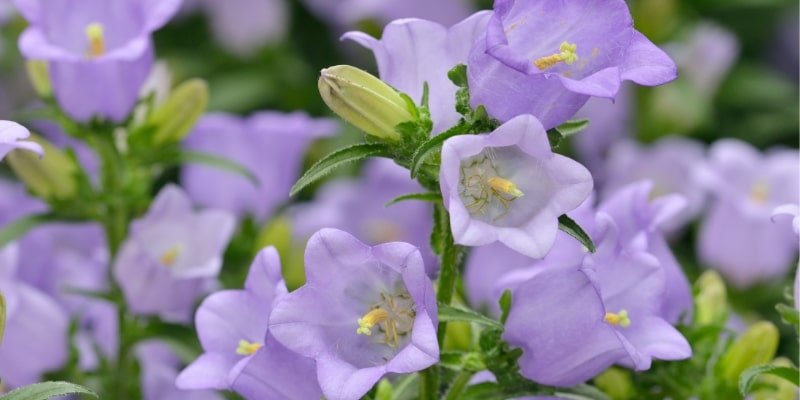 Scientific Name: Campanula medium
Scientific Name: Campanula medium
Plant Type: Annual/Biennial
Plant Size: 20-28 inches tall
Sun Exposure: Partial sun to full sun
Plant Zone: 5-8
Geographic Origin: Southern Europe
Though not all cultivars are purple, these flowers have a bell shape. Look for types that have more purple flowers than some other Campanula medium varieties, such as Bells of Holland, Dwarf Bella Mix, and Double Melton Mix.
When planting, consider positioning them in the garden’s second or third row so they can flaunt their height without obstructing your view of the smaller plants.
6. Catmint
 Scientific Name: Nepeta
Scientific Name: Nepeta
Plant Type: Perennial
Plant Size: 8 inches
Sun Exposure: Partial shade to full sun
Plant Zone: 4-8
Geographic Origin: Eastern, Southwestern North America
The Nepeta contains over 250 different species. The original variety features vibrant purple flowers, and the majority are perennials. There are additional colours available, as well as other shades of purple, such as lilac or violet, which may be found in other cultivars.
Most likely, you’ve heard of the Nepeta cataria type, sometimes known as catnip. Since that’s the only one that draws crazy cats, you might want to stay away from planting it in your garden.
7. China Aster
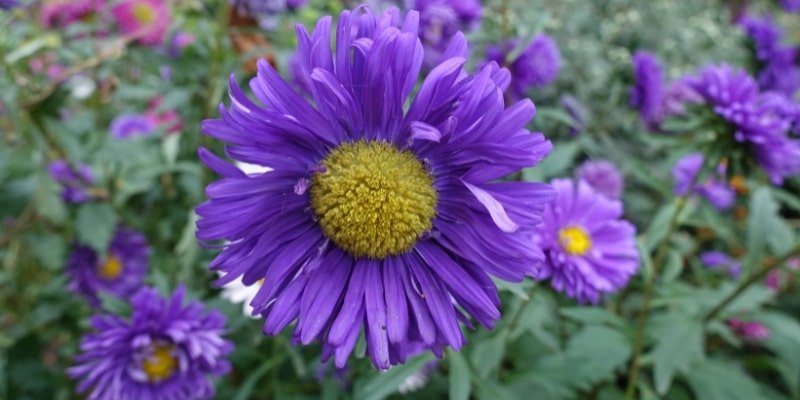 Scientific Name: Callistephus chinensis
Scientific Name: Callistephus chinensis
Plant Type: Annual
Plant Size: 3 feet tall
Sun Exposure: Full sun to partial shade
Plant Zone: 2-11
Geographic Origin: China, Southern Russia
The China Aster boasts beautifully puffed, frequently globular blooms of several petals resembling daisies. Many of the kinds feature purple flowers that range in size from three to five inches. Some are dense with hundreds of petals, while others are sparser.
These striking bloomers are perfect for extensive gardens, container planting, or even wild gardens from early summer to mid-fall. It actually just takes a lot of food and water for them to flourish; therefore, you should make sure you fertilize and wet the soil frequently.
8. Common Comfrey
 Scientific Name: Symphytum officinale
Scientific Name: Symphytum officinale
Plant Type: Perennial
Plant Size: 1-4 feet tall
Sun Exposure: Part shade to full sun
Plant Zone: 4-9
Geographic Origin: North America, Europe, Western Asia
Common comfrey grows readily and enjoys moist soil. Thus, some regarded it as a weed. It comes in a wide variety, many of which have purple blossoms.
Since they are wildflowers, they are very low-maintenance and easily reproduced. Their flower clusters are characterized by their curving, drooping shape.
Its roots go deep into the earth, drawing in many minerals and nutrients. Because of this, some organic gardeners apply fertilizer to the leaves.
9. Corydalis
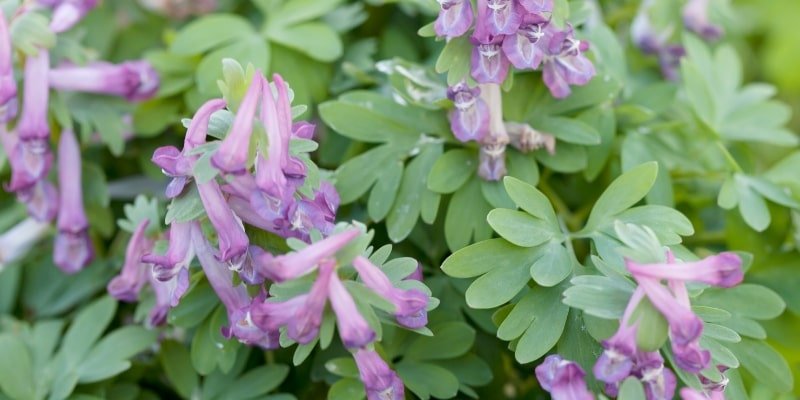 Scientific Name: Corydalis
Scientific Name: Corydalis
Plant Type: Perennial/Annual
Plant Size: 1-3 feet tall
Sun Exposure: Part sun to full sun
Plant Zone: 3-9
Geographic Origin: Northern Hemisphere, Tropical East Africa
Corydalis comes in hundreds of species, some of which are pink, blue, green, or yellow. However, other cultivators are recognized for their purple flowers, such as Corydalis buschi, Corydalis cava, Corydalis scouleri, Corydalis linstowiana, and Corydalis pauciflora.
Since butterfly larvae feed on various species, they often draw pollinators to your garden area. While some kinds, such as Corydalis caseana, are toxic to cattle, these flowers may have medicinal qualities.
10. Dahlia
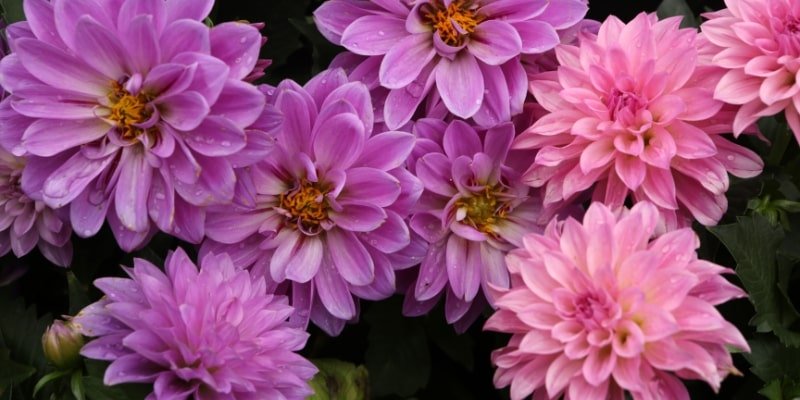 Scientific Name: Dahlia
Scientific Name: Dahlia
Plant Type: Perennial (Zones 8-11); Annual
Plant Size: 2 feet to 7 feet
Sun Exposure: Partial to Full Sun
Plant Zone: 3-11
Geographic Origin: South America, Mexico
Many gardeners find dahlias to be a popular flower. Many recognize their resilience and affection for the sun. Certain types can grow fairly tall in the correct settings, and they can tolerate a little neglect.
Though soil should drain properly, they do prefer to thrive in more humid climates because they require regular irrigation.
Over the past ten years, dahlias have seen a sharp increase in popularity. They have a wide range of colours and yield some of the most exquisite blooms on this list.
11. Foxglove
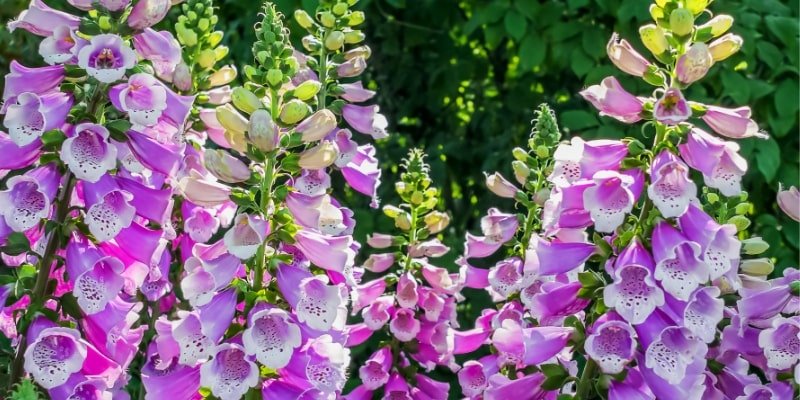 Scientific Name: Digitalis
Scientific Name: Digitalis
Plant Type: Perennial/Biennial
Plant Size: Up to 2-5 feet tall
Sun Exposure: Full sun to partial shade
Plant Zone: 4-8
Geographic Origin: Europe
The blossoms of foxglove are really unusual, but they also fade quickly. The long, spiky stalks and green foliage are striking even before the blossoms open. Large clusters of trumpet-shaped blooms hang from the plant’s side once they bloom.
The colour patterns on the inside of the flowers can differ from those on the outside. It’s possible that the name “Digitalis” comes from the way its blossoms resemble thimbles and fit snugly on fingers.
12. Globe Artichoke
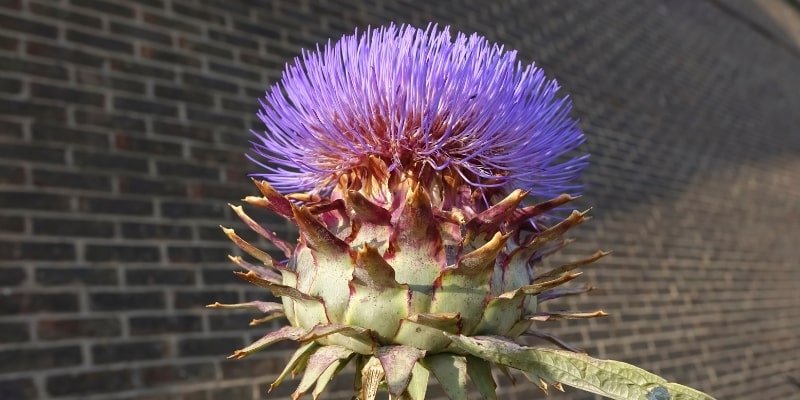 Scientific Name: Cynara cardunculus
Scientific Name: Cynara cardunculus
Plant Type: Perennial
Plant Size: Up to 6 feet tall
Sun Exposure: Full sun
Plant Zone: 7-9
Geographic Origin: Mediterranean
The globe artichoke is visually striking, even in its non-blooming state, with purple blossoms. As they mature, young leaves turn greenish-grey, often reaching lengths of three feet. From nodes on the stem, tall flower stalks grow until the massive, spiky flowers appear.
Edible heart-shaped blooms on globe artichokes. Thus, before they open, they are harvested. Huge purple flowers with hundreds of spiky petals emerge when left to bloom, putting on quite the show.
13. Gloxinia
 Scientific Name: Sinningia speciosa
Scientific Name: Sinningia speciosa
Plant Type: Perennial bulb
Plant Size: 6 to 12 inches tall
Sun Exposure: Part shade to full shade
Plant Zone: 11-12
Geographic Origin: Brazil
Gloxinia is frequently grown as a houseplant because of its incredibly eye-catching blossoms. Although container plants don’t like the cold, you can bring them outside during the warmer months.
Although these plants require a lot of care, they are dependable seasonal bloomers that have the potential to bloom twice a year.
Hybrid cultivars that grow beautiful trumpet-shaped flowers in pastel colours, including various shades of purple, are called “florists’ gloxinia.” These hybrids also feature exceptionally enormous flowers with deep cups decorated with a multi-coloured design that is frequently framed in white.
14. Heliotrope
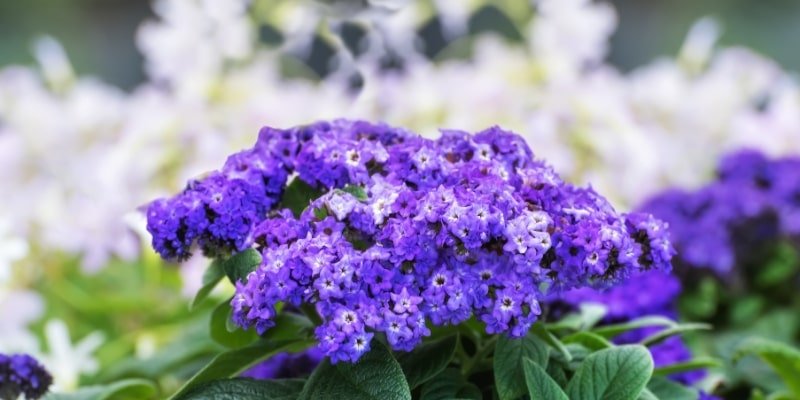 Scientific Name: Heliotropium
Scientific Name: Heliotropium
Plant Type: Perennial
Plant Size: 2 feet tall
Sun Exposure: Full sun to partial shade
Plant Zone: 10-12
Geographic Origin: Peru
Heliotrope blooms are often violet or purple and grow in dense clusters. They might be white or mauve as well. The first blossoms occur in the summer after some of the spring bloomers have already slowed down. Their leaves are delicate and verdant.
The tiny blossoms persist into the autumn, clumped together so closely that they resemble one unit. Heliotrope is highly harmful to humans, dogs, and cats, so you might want to avoid adding it to your garden if you have curious pets or children.
15. Hollyhock
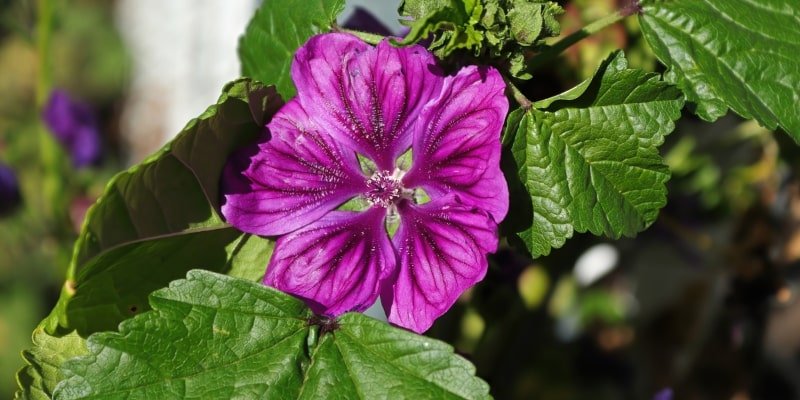 Scientific Name: Alcea
Scientific Name: Alcea
Plant Type: Annual
Plant Size: 3 – 8 feet tall
Sun Exposure: Full sun
Plant Zone: 3-8
Geographic Origin: Eastern, Southwestern North America
Even the smallest, mature hollyhock plants have the potential to grow to considerable heights. You’ll need to exercise patience if you plant them from seed. They are gathering and storing energy so that they won’t bloom the first year.
The following year, as the tall stalks rise from their base of greenery, the stored energy will burst forth in the shape of dozens of vibrant blossoms. After each bloom, they release their seed, which allows them to propagate and self-sow.
Minor types, like “Creme de Cassis,” are raspberry to purple, while others might be pink, rose, crimson, or even nearly black. They grow rather well with minor assistance.
16. Browallia
 Scientific Name: Browallia speciosa
Scientific Name: Browallia speciosa
Plant Type: Annual/Perennial
Plant Size: 1-2 feet tall
Sun Exposure: Full sun to partial shade
Plant Zone: 10-11
Geographic Origin: South America
Browallia, sometimes called Bush Violet, is a warm-weather annual frequently grown. Plants are grown as annuals in milder areas. They are members of the nightshade family with woody stems.
Their purple flowers are tubular, with five different lobes. Although the flowers might occasionally lean more towards blue tones, purplish flowers with a white centre are the most common.
17. Purple Flash
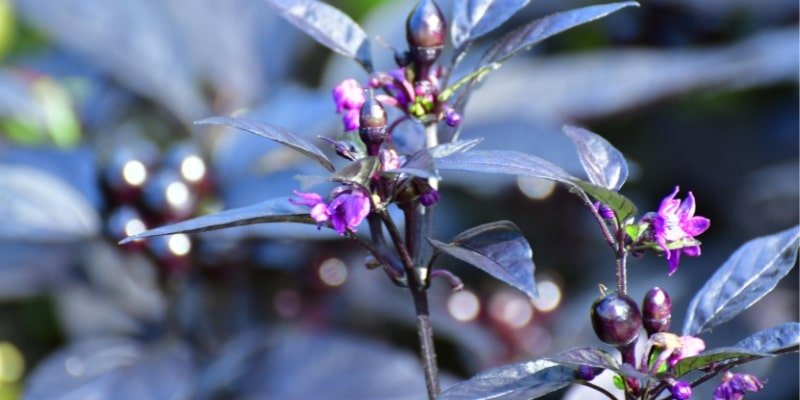 Scientific Name: Capsicum annuum
Scientific Name: Capsicum annuum
Plant Type: Annual
Plant Size: 13-15 inches tall
Sun Exposure: Full sun
Plant Zone: 4-9
Geographic Origin: Eastern, Southwestern North America
A type of hot pepper plant called purple flash is frequently planted for aesthetic purposes. The tiny, spherical peppers grow as the leaves change from green or white to vivid purple, dark purple, and occasionally black.
Although they thrive in warm weather (above 74 degrees), they can also be grown outdoors in gardens.
18. Spike Speedwell
 Scientific Name: Veronica spicata
Scientific Name: Veronica spicata
Plant Type: Perennial
Geographic Origin: Europe and Asia
Plant Size: 2-3 feet tall
Sun Exposure: Full sun
Plant Zone: 3-9
The late spring blooms of Spike Speedwell are tall, spiky, and purple. They prefer sunny gardens with soil that drains well, but they grow readily and are generally tolerant of less-than-perfect circumstances.
Claw back the stem to force a fall bloom once the initial one fades. Dark purple flowers can be found by searching for cultivars named “Purpleicious.”
19. Zinnia
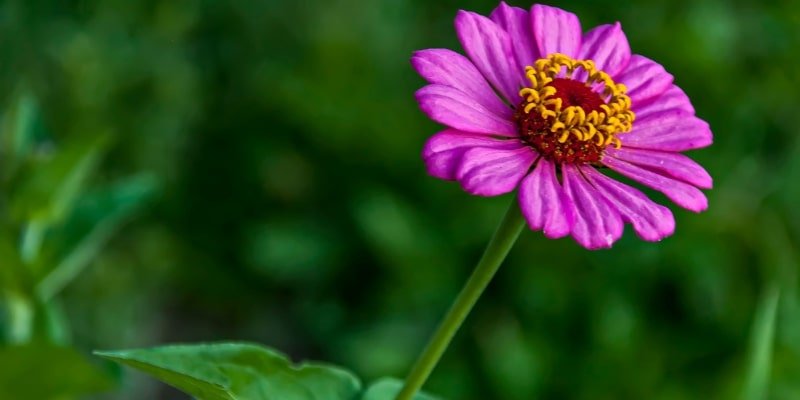 Scientific Name: Zinnia
Scientific Name: Zinnia
Plant Type: Annual
Geographic Origin: South America and North America
Plant Size: 6 inches
Sun Exposure: Full sun
Plant Zone: 3-10
Zinnias are relatively easy to grow, and when they bloom, they reward gardeners with vibrantly coloured pom-pom flowers. Typical flowers are lavender and purple, while zinnia comes in a range of colours.
They attract hummingbirds, bees, and butterflies over their extended blooming season. They also remain in the area for a considerable amount of time.
20. Yesterday, Today Tomorrow
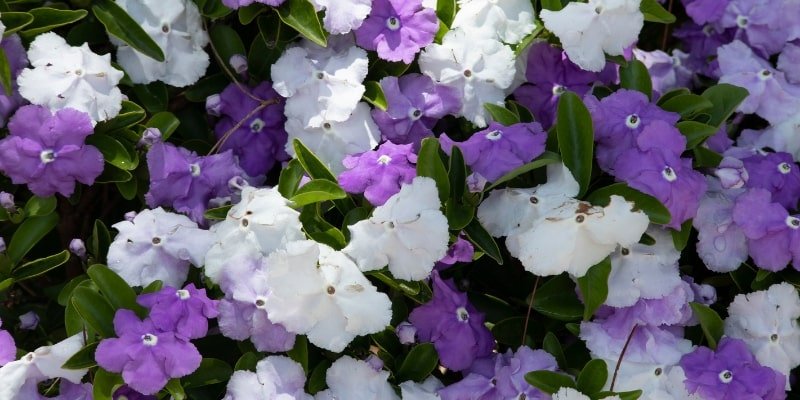 Scientific Name: Brunfelsia pauciflora
Scientific Name: Brunfelsia pauciflora
Plant Type: Perennial
Plant Size: 3-5 feet tall
Sun Exposure: Full sun to partial shade
Plant Zone: 9-11
Geographic Origin: Eastern, Southwestern North America
This nightshade family member is also known as Kiss-Me-Quick and Lady-of-the-Night. It grows as a shrub. The aromatic blooms are most abundant in the spring and autumn, but they can bloom whenever the conditions are right.
The blossoms begin as deep purple and then pale purple, lavender, and finally white as they fade.
21. Sweet Rocket
 Scientific Name: Hesperis matronalis
Scientific Name: Hesperis matronalis
Plant Type: Perennial
Plant Size: 1-3 feet tall
Sun Exposure: Full sun to partial shade
Plant Zone: 3-8
Geographic Origin: Europe
Purple flowers are seen in certain cultivars of sweet rocket, which has a powerful evening scent. Although it’s not a true wildflower, it’s frequently used in mixes of wildflower seeds.
Sweet rocket plants have enormous, vibrant flower clusters when they bloom in the spring. The coarse foliage can be consumed.
22. Hydrangea
 Scientific Name: Hydrangea macrophylla
Scientific Name: Hydrangea macrophylla
Plant Type: Perennial
Plant Size: 2-9 feet tall
Sun Exposure: Full sun with afternoon shade
Plant Zone: 4-9
Geographic Origin: Asia, the Americas
Woody bushes called hydrangeas are known for their puffy, big, ruffled flowers. The pH of the soil in which hydrangeas are cultivated and the particular species you have planted will determine the exact colour of the blossoms.
The blossoms are usually white, although they can also be pink, red, blue, or purple. Increasing or decreasing the soil’s acidity or baseness causes yearly colour changes.
Depending on the kind, they can grow both indoors and outdoors. The leaves have a lot of texture and size. Every flower is a puffy globe composed of several tiny petals. Every year, hydrangeas need to be pruned to prevent their woody stems from getting messy.
23. Globe Thistles
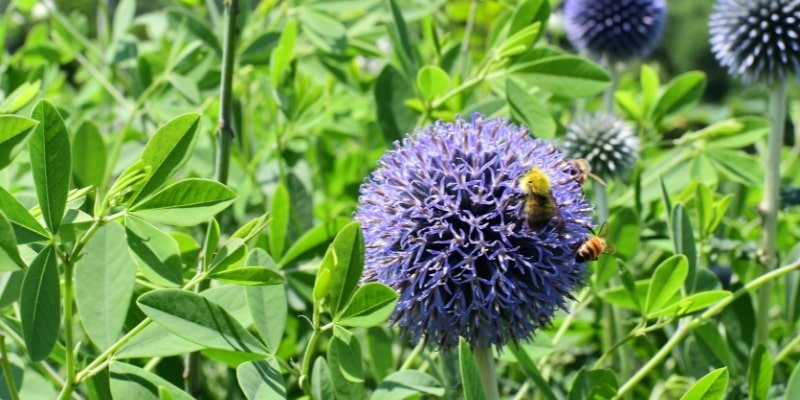 Scientific Name: Echinops
Scientific Name: Echinops
Plant Type: Perennial
Plant Size: 2 to 6 feet tall
Sun Exposure: Full sun
Plant Zone: 3-9
Geographic Origin: Southern Europe, Central Asia
Globe thistles can withstand moderately dry circumstances and grow effectively in shallow, rocky soil. Their tall, thin stalks are topped with flower heads.
The flowers are spiky globes covered with many prickly white spines and with centres ranging from dark blue to purple. Both certain butterflies and human eyes find them to be highly appealing.
They may give your garden a great lift, and even when their bloom starts to fade, the seed heads still make an intriguing visual feature.
24. Fuchsia
 Scientific Name: Fuchsia
Scientific Name: Fuchsia
Plant Type: Perennial
Plant Size: 8 inches
Sun Exposure: Partial shade to full sun
Plant Zone: 6-9
Geographic Origin: South America, Mexico, Australia
Since most fuchsias are native to tropical regions, they enjoy warm, damp settings. Their enormous, heavy blossoms dangle downward, forcing the slender branches to sag under their weight. They resemble shrubs.
There are two kinds of petals on the flowers: an inner set of tighter, larger petals and an outside set of four long, thin petals. Purple is a standard colour for the inner petals.
25. Evening Primroses
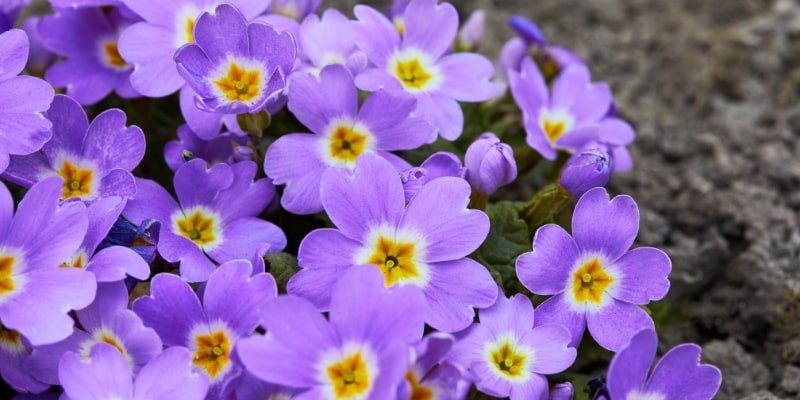 Scientific Name: Onagraceae
Scientific Name: Onagraceae
Plant Type: Perennial
Plant Size: 2-3 feet tall
Sun Exposure: Part sun to full sun
Plant Zone: 3-9
Geographic Origin: Eastern, Southwestern North America
The purple, white, pink, or red blossoms of the evening primrose emerge in the evening. Another family of plants entirely, common primrose, is frequently yellow in colour.
In light of this, exercise caution while shopping and seek out the purple evening primrose varieties. A unique stigma featuring four cross-shaped branches adorns the papery flowers.
26. Dwarf Rhododendron
 Scientific Name: Rhododendron impeditum
Scientific Name: Rhododendron impeditum
Plant Type: Flowering evergreen
Plant Size: around 1 foot tall
Sun Exposure: Full sun to partial shade
Plant Zone: 4-8
Geographic Origin: China
This rhododendron species grows slowly and is woody. The plant’s tendency to increase as wide as it is tall makes it attractive for use as ground cover, and the leather leaves are an unusual addition to any garden. Then, in the spring, they bloom a carpet of tiny purple blooms that cover the plants.
27. Cyclamen
 Scientific Name: Cyclamen persicum
Scientific Name: Cyclamen persicum
Plant Type: Perennial
Plant Size: 2-3 feet tall
Sun Exposure: Partial shade
Plant Zone: 8 to 18 inches
Geographic Origin: Mediterranean
The typical flower colours of this Cyclamen type include dark magenta, purple, light pink, and white. Rich soil facilitates their growth, and they produce clusters of heart-shaped, variegated leaves with patterns in different tones of green.
The long, airy petals of the flowers, which bloom from October into winter, nearly stand vertically.
28. Blue-Eyed Grass
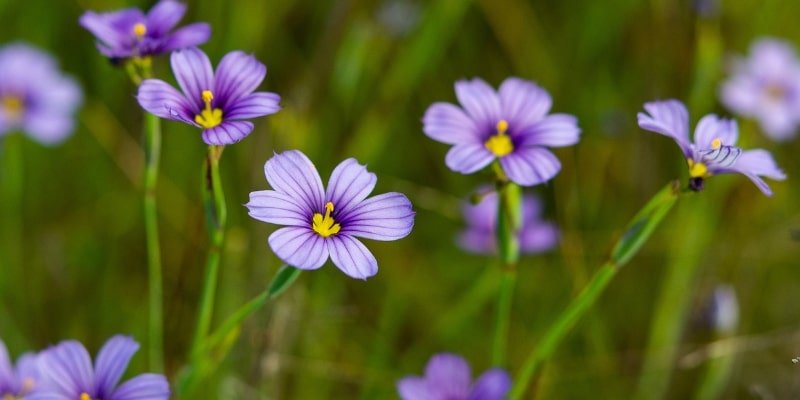 Scientific Name: Sisyrinchium
Scientific Name: Sisyrinchium
Plant Type: Perennial
Plant Size: 2-3 feet tall
Sun Exposure: Full sun to shade
Plant Zone: 4-9
Geographic Origin: North America
Blue-Eyed Grass belongs to the family Iris. Open meadows and widely separated woodlands are ideal habitats for these plants. The plants grow in clusters and have blady, slender stems that resemble Grass before they bloom.
Then, their little purple flowers blossom in the early spring. These blossoms are nearly invariably purple, with colours ranging from light lavender or lilac to dark blue.
Since they don’t require additional watering or fertilizer, they thrive in natural gardens.
29. Bittersweet Nightshade
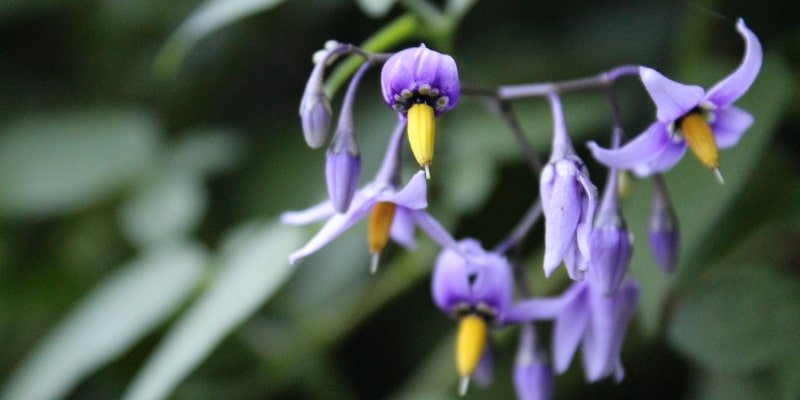
Scientific Name: Solanum dulcamara
Plant Type: Perennial
Plant Size: Up to 30 feet tall
Sun Exposure: Part sun to full sun
Plant Zone: 4-8
Geographic Origin: Europe and Asia
While Bittersweet Nightshade is not as deadly as its relative Deadly Nightshade, it is nevertheless hazardous to people, animals, and pets.
The triangular-patterned leaves are a deep, dark green colour. This plant can resemble a vine, or it can be more woody and shrub-like. It can be found along the side of the road or on the edge of a field.
With a yellow cone in the center, the flowers are either lavender or vivid purple. When their berries are ripe, fully grown, and vivid red, they draw birds’ attention.
30. Bell Flowers
 Scientific Name: Campanula
Scientific Name: Campanula
Plant Type: Perennial/Annual/Biennial
Plant Size: 6 inches
Sun Exposure: Part sun to full sun
Plant Zone: 3-9
Geographic Origin: Worldwide
Bell flowers got their name because of their unusually rounded, bell-shaped form. More than 300 different kinds with global origins are available. Thus, some alpine kinds are relatively small, while others are much taller and survive in rugged forests.
The fact that these low-maintenance plants bloom late in the spring and all summer is one of their most alluring qualities to gardeners. You may discover a variety that thrives in your garden because there are so many to choose from.
31. Aster
 Scientific Name: Aster
Scientific Name: Aster
Plant Type: Perennial
Plant Size: 1-8 feet tall
Sun Exposure: Part sun to full sun
Plant Zone: 3-10
Geographic Origin: New York and New England
Butterfly attraction abounds in the daisy-like perennial aster plant. As some other plants begin to fade, the numerous blooms occur late in the season, from almost the end of summer to the beginning of fall.
Because their late blooming coincides with the Michaela’s holiday in late September, they have earned the nickname “Michael’s daisies.”Their flower heads resemble stars, and some asters can get very tall, depending on the particular cultivar.
32. Annual Honesty
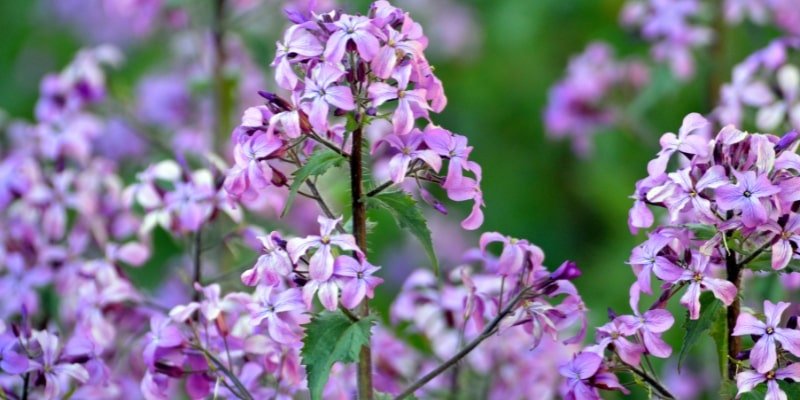
Scientific Name: Lunaria Annua
Plant Type: Perennial
Plant Size: 2-3 feet tall
Sun Exposure: Partial shade to full sun
Plant Zone: 5-9
Geographic Origin: Eastern, Southwestern North America
The silver dollar is another name for the annual honesty flower. This plant is easy to cut for a floral arrangement because it may grow pretty tall and has an abundance of papery flowers.
Late spring brings fragrant purple flowers, and in the midst of summer, globular fruits shaped like moons arrive.
The only possible drawback to this flower is that once well-established in your garden, it tends to spread swiftly. If neglected, it quickly approaches the status of an annoyance.
33. Anise Hyssop
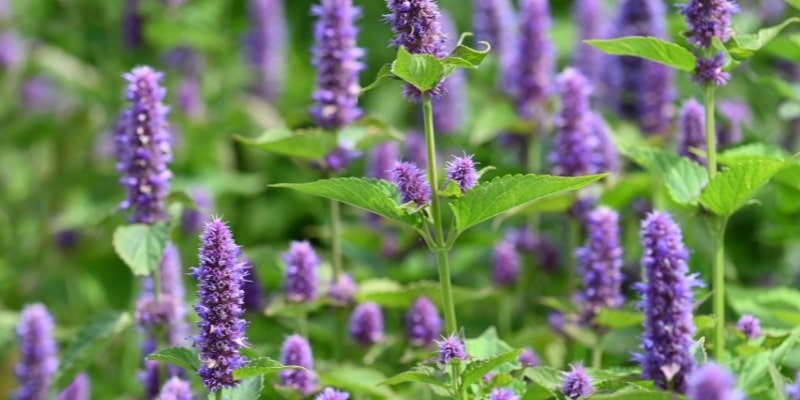 Scientific Name: Agastache foeniculum
Scientific Name: Agastache foeniculum
Plant Type: Perennial
Plant Size: Up to 4 feet tall
Sun Exposure: Part sun to full sun
Plant Zone: 4-8
Geographic Origin: North America Plains
You would be correct if you assumed that this flower smelled slightly like licorice, if you had ever cooked with anise. Conical flowers that draw a large number of butterflies, bumblebees, hummingbirds, and other pollinators in droves are produced by a single plant.
Their blossoms are vibrant purple to deep indigo, and they grow well in raised beds, meadows, gardens, and containers.
34. Alpine Betony
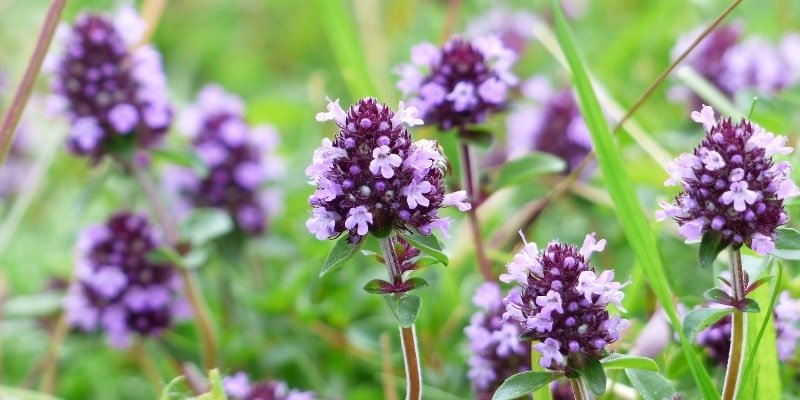 Scientific Name: Stachys Monieri
Scientific Name: Stachys Monieri
Plant Type: Perennial
Plant Size: 18-24 inches tall
Sun Exposure: Partial shade to full sun
Plant Zone: 3-4
Geographic Origin: Europe to Western Siberia
The mint family includes the Alpine betony. The flowers are tubular and spiky, while the leaves are leathery and green. Long stems that emerge from the leaves of these drought-tolerant blooms end in a vivid purple (or occasionally pink) blossom.
They draw a large number of pollinators. They provide an excellent protective border because deer and rabbits tend to stay away from them.
35. Allium Ornamental
 Scientific Name: Alliums
Scientific Name: Alliums
Plant Type: Perennial
Plant Size: 2-3 feet tall
Sun Exposure: Part sun to full sun
Plant Zone: 3-9
Geographic Origin: Eastern, Southwestern North America
Some well-known names, such as onions, garlic, and chives, belong to the allium genus. Alliums grown for their long, solitary stalks and puffy, globular flowers are also available; these alliums are frequently hybrids.
Their big blossoms give your garden a pop of purple and lend height to their frequently three-foot stature. They retain their flowers for a considerable amount of time, and even when they fade, they remain distinctive and easy to identify.
36. Cup-and-Saucer Vine
 Scientific Name: Cobaea scandens
Scientific Name: Cobaea scandens
Plant Type: Perennial
Plant Size: 5-40 feet tall
Sun Exposure: Part sun to full sun
Geographic Origin: Mexico, Central America
The naturally long and exceptionally fast-growing cup-and-saucer vines allow them to develop to astounding heights and widths. The violet blossoms have rounded, ruffled edges and a cup-like form.
Furthermore, each flower has a ruff surrounding its base, which resembles a saucer on which the cup of the flower is placed.
37. Dianthus
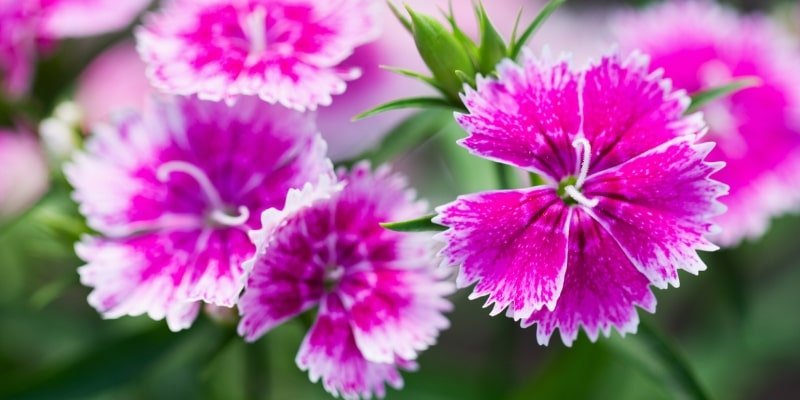 Scientific Name: Dianthus spp.
Scientific Name: Dianthus spp.
Plant Type: Perennial/Annual/Biennial
Plant Size: 6 inches
Sun Exposure: Part sun to full sun
Plant Zone: 3-9
Geographic Origin: Europe, Asia, parts of Africa, North America
Dianthus comes in a wide range of types. Dianthus has many varieties, some with purple flowers, including sweet William and carnations.
Flowers of almost every kind have scalloped edges and are ruffled. Certain flowers, like carnations, have two rows of petals, whereas others have just one row.
Pollinators find the blooms appealing, and they are arranged in relatively large clusters.
38. European Periwinkles
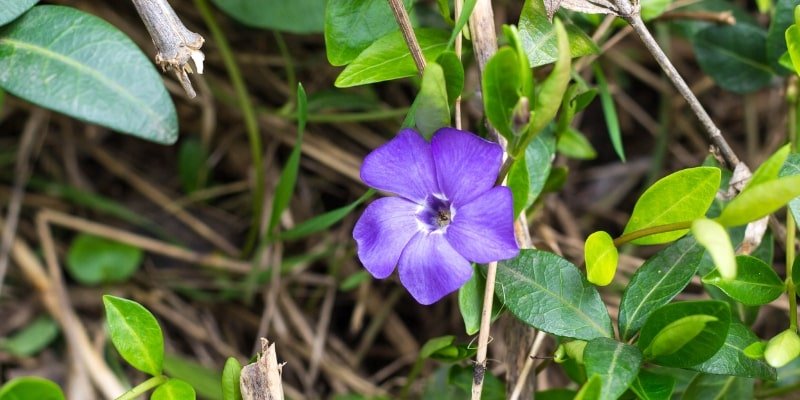 Scientific Name: Vinca
Scientific Name: Vinca
Plant Type: Perennial
Plant Size: 6 inches
Sun Exposure: Partial shade to full sun
Plant Zone: 4-9
Geographic Origin: Europe, parts of Africa
Vinca plants have trailing branches that can take root anywhere they come into contact with soil. As a result, they frequently spread quickly.
The European periwinkle, sometimes referred to as creeping myrtle, has vivid pentagonal bloom centers surrounded by five petals and dark green foliage.
39. Hummelo Betony
 Scientific Name: Stachys officinalis ‘Hummelo’
Scientific Name: Stachys officinalis ‘Hummelo’
Plant Type: Perennial
Plant Size: 18-24 inches tall
Sun Exposure: Full sun
Plant Zone: 4-8
Geographic Origin: Eastern, Southwestern North America
One particular strain of Stachys monieri is called hummelo. Long, thin stems emerge from bunches of low-growing, textured leaves. The tall, spiky stems produce conical, purple flowers with spikes in midsummer, and the leaves are pretty textural.
40. Carnation
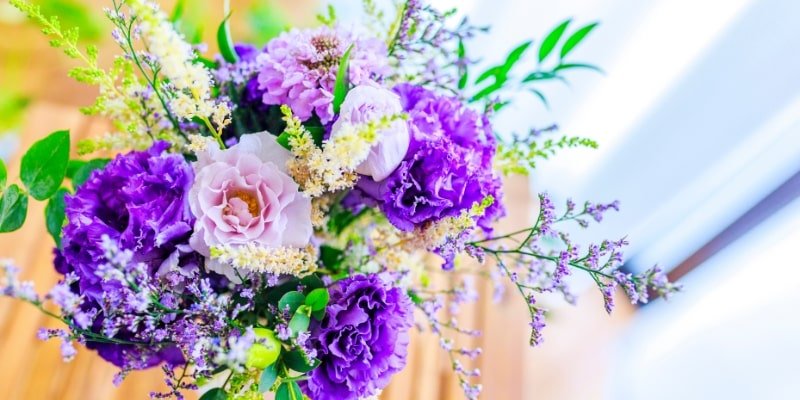
Scientific Name: Dianthus Caryophyllus
Plant Type: Perennial
Plant Size: 1-4 feet tall
Sun Exposure: Full sun to partial shade
Plant Zone: 6-9
Geographic Origin: Eastern, Southwestern North America
There are many varieties of carnations, but most of them, including the original, have a purple tint. Every flower contains seven to twenty rays, or ruffled petals, which can frequently get fairly significant and resemble saucers.
Some flowers are varied, which makes them popular for boutonnieres, bouquets, and corsages. Other flowers may be entirely one colour.
41. Cattleya Orchids
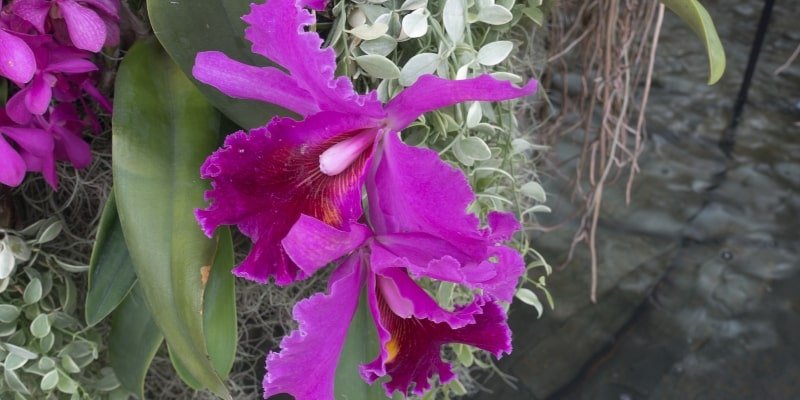 Scientific Name: Cattleya Orchid
Scientific Name: Cattleya Orchid
Plant Type: Perennial
Geographic Origin: South America
Plant Size: 3 feet tall
Sun Exposure: Bright but filtered, partial sun
Plant Zone: 10-12
“Brazilian Orchids” prefer damp soil and warm, humid air. Owing to their erratic behaviour, ensure that the roots are not exposed to excessive or insufficient sunlight and refrain from placing them in poorly-draining soil.
Cattleya orchids grow well in outdoor gardens in warmer, humid conditions, but in most other parts of the world, orchids are best suited as houseplants.
When healthy, they will produce rather large flowers with varying degrees of lavender and purple variegation in the pattern, depending on the cultivar. Some red or pink varieties may also appear somewhat purple.
42. Crocus
 Scientific Name: Crocus Vernus
Scientific Name: Crocus Vernus
Plant Type: Perennial
Plant Size: 6 inches tall
Sun Exposure: Full sun to partial shade
Plant Zone: 3-8
Geographic Origin: Alpine regions of Europe
One of the first flowers of spring, crocus, blooms from bulbs. Even when there is still some snow on the ground, by late March or early April, you can observe these ground-hugging blooms opening for a sunny day.
When it’s cloudy and rainy, they occasionally remain closed all night. Bees are drawn to these purple blooms because they are often highly fragrant.
43. Dwarf Iris
 Scientific Name: Iris reticulate
Scientific Name: Iris reticulate
Plant Type: Perennial
Plant Size: 6 inches tall
Sun Exposure: Full sun to partial shade
Plant Zone: 5-9
Geographic Origin: Russia, United States
Dwarf iris never reaches a height of more than six inches, in contrast to their full-sized cousins. Their petals are ribbed and slightly blade-shaped, and they are floppy. Early in the spring, they produce beautiful, fragrant flowers.
As the season progresses, the flowers tend to require less and less water, though they still love it a lot when they’re blooming.
44. False Goat’s Beard
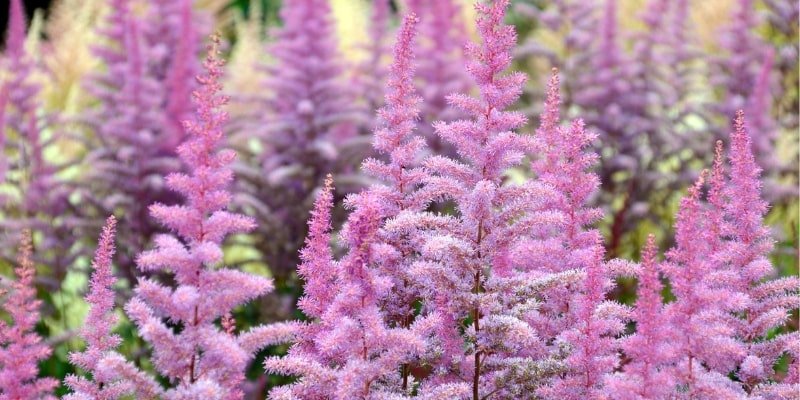
Scientific Name: Astilbe
Plant Type: Perennial
Geographic Origin: Eastern, Southwestern North America
Plant Size: 4-6 feet tall
Sun Exposure: Partial sun to full sun
Plant Zone: 3-9
There are eighteen varieties of Astilbe, and most of them prefer soil that is moister than usual; thus, they are a wonderful option for backyard gardens that are damp or close to a pond. Cone-shaped plumes of featheriness are produced by the flowers.
Astilbe stems nearly always grow vertically, with deep green leaves surrounding the base that resemble ferns. They can give a garden a lot of height.
45. Gladiolus
 Scientific Name: Gladiolus
Scientific Name: Gladiolus
Plant Type: Annual
Plant Size: 2-5 feet tall
Sun Exposure: Full sun
Plant Zone: 7-10
Geographic Origin: Europe, Southern Africa
Gladiolus is an excellent option for compact gardens with limited horizontal area because of its quick growth and potential height. The term “sword lily” comes from the flowers’ blade-like petals.
Because the blossoms of gladioli are frequently purple and have a strong colour, vegetable gardeners include them in their gardens to draw pollinators.
46. Honeywort
 Scientific Name: Cerinthe major
Scientific Name: Cerinthe major
Plant Type: Perennial
Plant Size: 2-4 feet tall
Sun Exposure: Partial shade to full sun
Plant Zone: 7-10
Geographic Origin: Mediterranean
Honeywort blossoms might vary somewhat in tone, but they are virtually always a rich purple. As the buds mature and bloom, they get heavier and heavier until they eventually dangle towards the earth.
The robust stems stay erect, and the blossoms frequently continue to nod from spring into summer. At times, vibrant outer petals, or bracts, envelop the core bloom.
47. Leather Flower
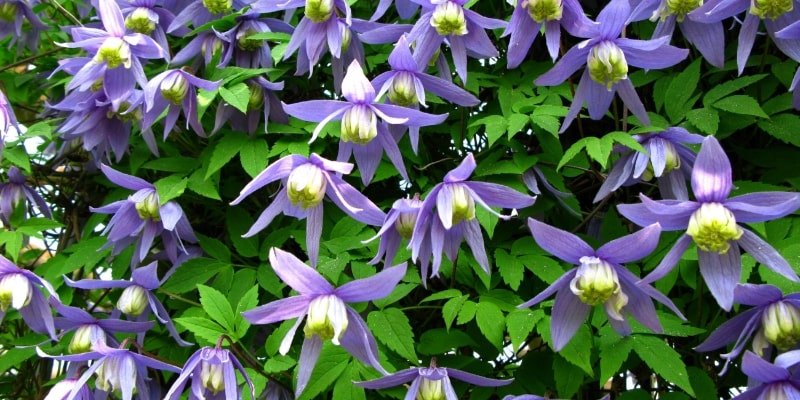
Scientific Name: Clematis versicolor
Plant Type: Perennial
Plant Size: 6-16 feet tall
Sun Exposure: Part shade to full sun
Plant Zone: 5-9
Geographic Origin: Southeastern United States
The flower with pale leather tones is a kind of clematis. When left undisturbed, its delicate stems and lengthy viny tendrils can reach relatively large lengths.
However, the stems can also break easily when handled or exposed to severe winds; thus, having a trellis or arbour provides robust support to help avoid breakage.
The one-inch, bell-shaped flowers come in various colours, from light, nearly white purple too much deeper tones, and they usually hang in a nod.
48. Lily of the Nile
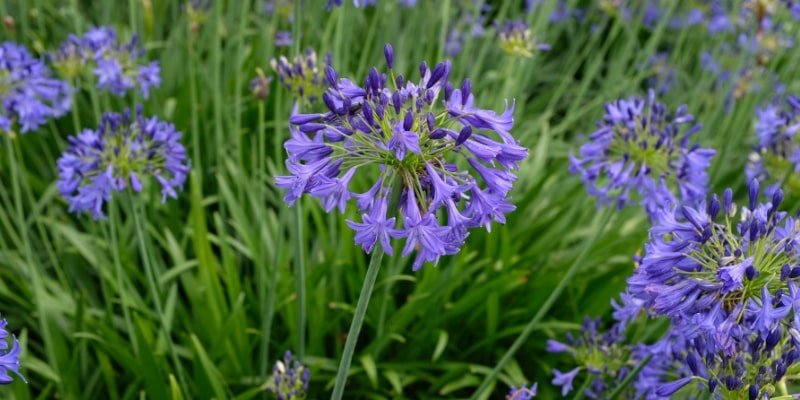
Scientific Name: Agapanthus orientalis
Plant Type: Perennial
Plant Size: 1-4 feet tall
Sun Exposure: Full sun to partial shade
Plant Zone: 9-11
Geographic Origin: Eastern, Southwestern North America
Brutal winters will prevent lilies of the Nile from growing because they need relatively warm weather. Their flower heads, composed of several little blooms with curled petals, are atop their long stems. Although delicate, the flowers are highly colourful and don’t survive very long.
Colours like brilliant purple, blue, or white can be seen in flower clusters. Cut them thin and arrange them in tall vases; their thin stems are perfect.
49. Meadow Sage
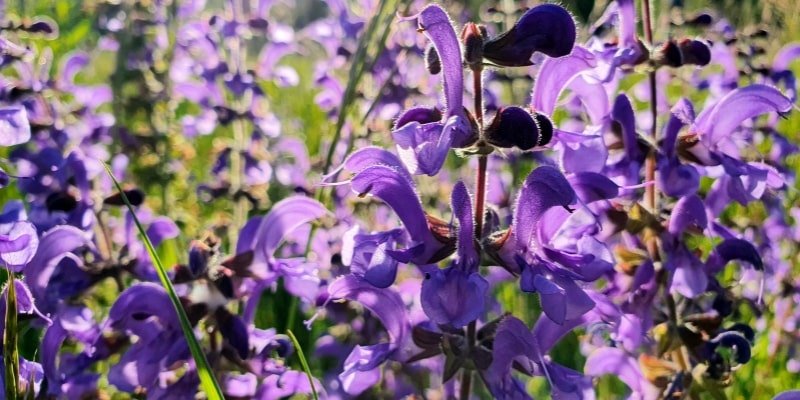
Scientific Name: Salvia nemorosa
Plant Type: Perennial
Plant Size: 1-3 feet tall
Sun Exposure: Full sun
Plant Zone: 3-9
Geographic Origin: Europe and Asia
The purple flowers of this Salvia species are frequently seen above its prickly racemes. They form clumps, and you can stimulate a second, late-season bloom by pruning the stems beneath wasted blooms.
When they are in full bloom, they draw much attention from bees and butterflies. There are plenty of varieties, so be sure to choose one that is the colour you like most.
50. Mistflower

Scientific Name: Conoclinium coelestinum
Plant Type: Perennial
Plant Size: 0.5-3 feet tall
Sun Exposure: Full sun to partial shade
Plant Zone: 5-10
Geographic Origin: West Indies, south-eastern United States
Mistflowers bloom in the latter part of summer or perhaps even autumn when the temperature drops. It is frequently called the hardy ageratum and shares many characteristics with the annual ageratum.
However, it features fluffy purple flowers and is a real perennial that spreads readily by seed.
It can become weedy and grows well even in damp environments. These plants are fantastic in wildflower gardens, but their spreading roots can be a nuisance in a strictly regulated garden.
51. Pansy
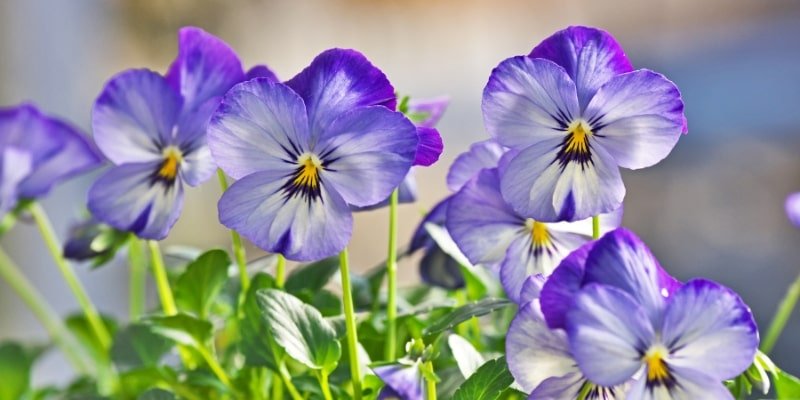
Scientific Name: Viola Tricolor
Plant Type: Perennial/Annual
Plant Size: 3- 10 inches tall
Sun Exposure: Full sun to partial shade
Plant Zone: 2-9
Geographic Origin: Europe
A well-liked but transient garden plant is the pansy. Often planted as annuals, they are not hardy outside of their zones. They can withstand frosts and enjoy cooler temperatures.
Usually planted in the autumn and allowed to overwinter in southern climates, they bloom from spring until summer. Their huge, colourful flowers emerge in the spring, but they rarely grow taller than a foot in diameter.
52. Pincushion Flower
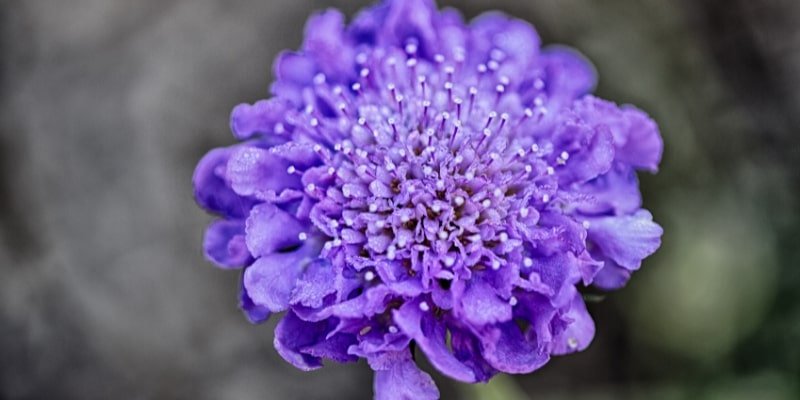
Scientific Name: Scabiosa atropurpurea
Plant Type: Annual
Plant Size: 2-3 feet tall
Sun Exposure: Full sun
Plant Zone: 3-6
Geographic Origin: Mediterranean
Pincushion flowers feature long, slender stems with tiny flowers with tiny projections that resemble pinheads, much like needles, at the apex. These plants require very little care, especially for annuals, while having many delicate lacy petals.
They might become perennial under the right circumstances and withstand winter. Most scabiosa plants have purple or lavender flowers, and hummingbirds and butterflies are drawn to them.
53. Russian Sage
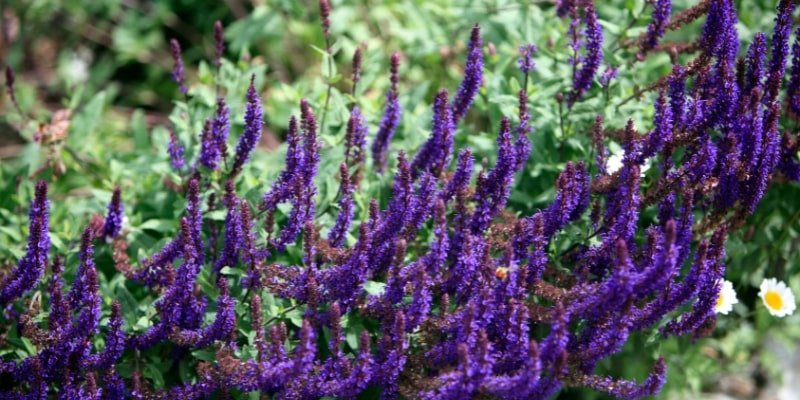
Scientific Name: Perovskia atriplicifolia
Plant Type: Perennial
Plant Size: 2-4 feet tall
Sun Exposure: Full sun
Plant Zone: 5-10
Geographic Origin: Central Asia
Once established in a garden, Russian sage, unlike other plants, likes dry circumstances. These plants are not only drought-tolerant but also quite resilient.
Their purple blossoms are spikey and tall, with the potential to become so heavy that the stalks topple over.
As a result, many gardeners place several Russian sage plants close together so that they can support one another and grow tall together, much like a field of vibrant wheat.
54. Wolf’s Bane
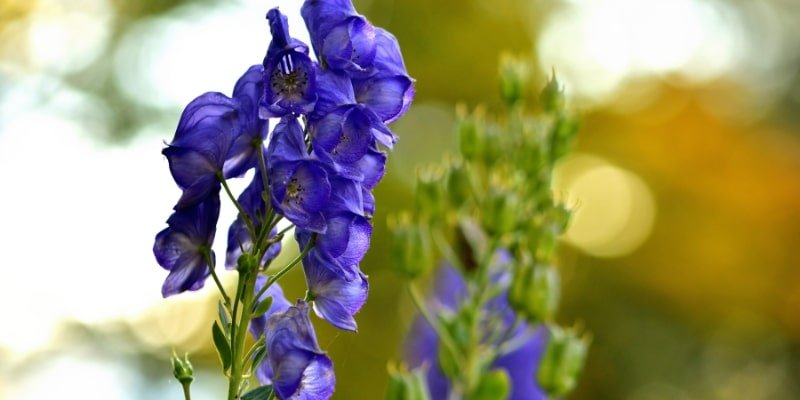
Scientific Name: Aconitum
Plant Type: Perennial
Plant Size: 2-3 feet tall
Sun Exposure: Part sun to full sun
Plant Zone: 3-9
Geographic Origin: Eastern, Southwestern North America
Monkshood is a poisonous plant, sometimes known by the name wolfs bane. They thrive in mountainous regions, damp forests, and northern-hemisphere woodlands with milder summers. The florets’ uppermost sepals grow into a characteristic shape that many have compared to a monk’s hood.
55. Lilac

Scientific Name: Syringa vulgaris
Plant Type: Perennial
Geographic Origin: The Balkans
Plant Size: 2-16 feet tall
Sun Exposure: Full sun
Plant Zone: 5-8
Purple-flowering lilac bushes are a common shrub. Small flower clusters that branch off these deciduous shrubs bloom from mid- to late spring. A very fragrant scent emanates from the blossoms. Blue-green to gray-green foliage can be found.
Once planted, these bushes require very little care. After flowering is complete, prune to remove extra growth. More recent cultivars that thrive in warmer climates are accessible.
56. Geraldton Wax flower

Scientific Name: Chamelaucium uncinatum
Plant Type: Shrub
Plant Size: 4-7 feet tall
Sun Exposure: Full sun
Plant Zone: 3-9
Geographic Origin: Australia
This evergreen shrub, often known as “Purple Pride,” bears purple blooms. Its little flowers tend to linger into early spring, and it blooms in late winter. As long as the temperature stays above 25 degrees, it can withstand harsh winters and doesn’t need a lot of water.
57. Prairie Gentian (Lisianthus)
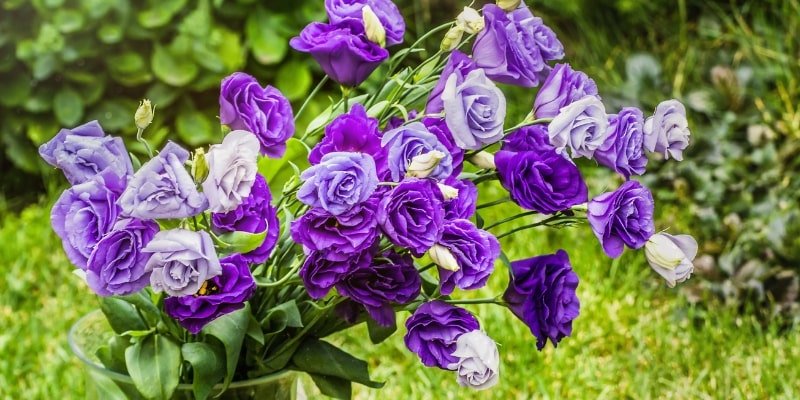
Scientific Name: Eustoma grandiflorum
Plant Type: Perennial
Plant Size: 2-3 feet tall
Sun Exposure: Full sun to partial shade
Plant Zone: 8-10
Geographic Origin: North America
Papery, deep purple flowers are the springtime bloom of this Lisianthus cultivar. These flowers have five petals and resemble roses in form. They can reach a width of two inches.
These are some of the most vibrant purple flowers available. They thrive in cutting gardens and in flower beds with other flowers since they can withstand irregular watering. They go by the name Lisianthus as well.
58. Garden Cosmos
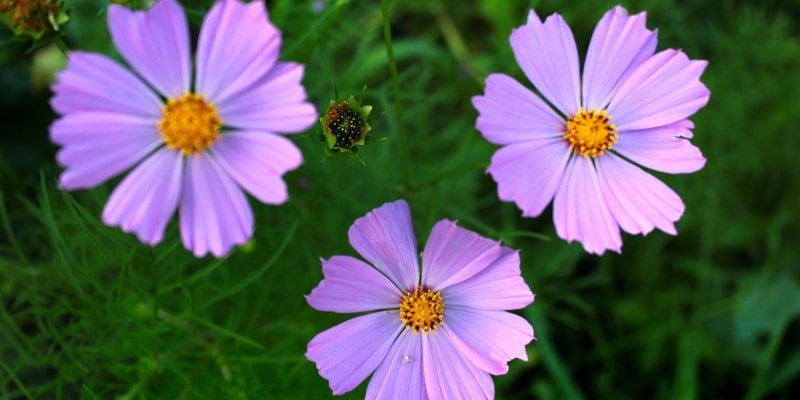
Scientific Name: Cosmos bipinnatus
Plant Type: Annual
Geographic Origin: Eastern, Southwestern North America
Plant Size: 2-3 feet tall
Sun Exposure: Full sun
Plant Zone: 2-11
Garden Cosmos are members of the daisy family and go by several names, including Mexican Aster. The flower flowers have ribbed teardrop-shaped petals and a bright yellow center.
They are two to four inches broad. These plants are highly valued for their aesthetic value in gardens and bouquets, as they can sustain and yield blossoms for several months. Despite being regarded as annuals, they can occasionally reseed on their own.
59. Chinese Wisteria
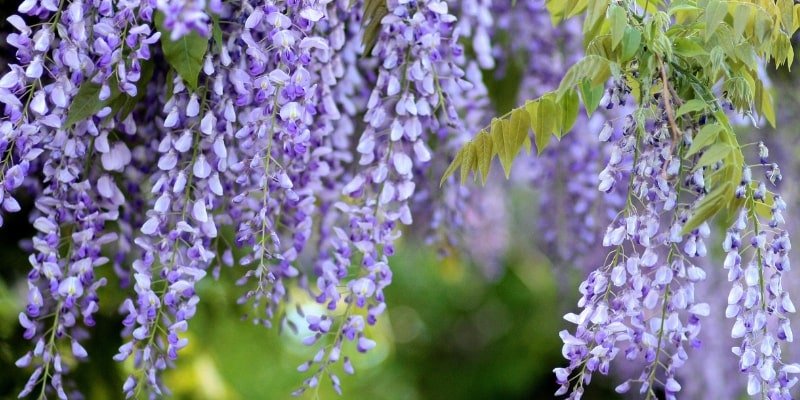 Scientific Name: Wisteria Sinensis
Scientific Name: Wisteria Sinensis
Plant Type: Perennial
Plant Size: 10-25 feet tall
Sun Exposure: Partial sun to full sun
Plant Zone: 4-9
Geographic Origin: Asia
Similar to other wisteria varieties, Chinese wisteria is toxic. Considering how quickly its vines spread, some people think it to be invasive, particularly in contrast to the less combative American variety. It does, however, produce clusters of drooping, blue-purple flowers when it blooms.
On robust frameworks like a pergola, arbor, or trellis, it grows best. Blooming can be encouraged by high-phosphorus fertilizers.
60. Camas Lily

Scientific Name: Camassia
Plant Type: Perennial
Plant Size: 1-4 feet tall
Sun Exposure: Full sun
Plant Zone: 4-8
Geographic Origin: Western North America
The blossoms of the Camas Lily can be purple, blue, or white, depending on the variety. For thousands of years, Native American cultures have used these plants—also known as Indian lilies and wild hyacinths—as food.
Look for Camassia leichtlinii and Camassia quamash if you’re searching for purple blossoms in various colours.
61. Bear’s Breeches

Scientific Name: Acanthus mollis
Plant Type: Perennial
Plant Size: 3-6 feet tall
Sun Exposure: Full sun to partial shade
Plant Zone: 7-10
Geographic Origin: Europe and Africa
Bearsfoot, Sea Dock, and Oyster Plants are other names for Bear’s Breeches. The leaves are vibrant, red-hued, and varied. The blooms are tubular, spikey, and tall.
Their flowers vary in colour from dark purple to practically white, and they have two outward-curling lips. Though they can tolerate many different garden conditions, keep these plants confined, just like you would with bamboo. If not, their roots will splay out widely.
62. Candytuft
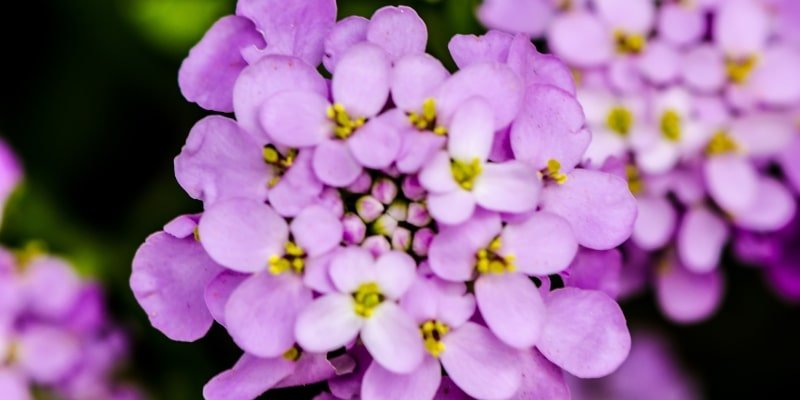
Scientific Name: Iberis
Plant Type: Perennial
Plant Size: 12-18 inches tall
Sun Exposure: Full to partial sun
Plant Zone: 7-11
Geographic Origin: Mediterranean
The purple blooms of the candytuft are borne close to the ground and appear in late spring. They are perfect as a ground cover to choke out weeds since they spread fast from year to year.
They work wonders at drawing pollinators into your garden as well. The dark green, somewhat dense foliage provides a little contrast to the other plants in your yard.
If you want purple flowers in your space, steer clear of the white and red cultivars, as not all of them are purple.
63. Cheeses (Common Mallow)

Scientific Name: Malva Sylvestris
Plant Type: Perennial
Plant Size: 2-5 feet tall
Sun Exposure: Partial sun to full sun, but tolerant of shade
Plant Zone: 3-9
Geographic Origin: Europe
This flowering plant, often known as common mallow or wild mallow, was formerly wholly wild. These days, it’s a typical garden accent, especially in Europe.
Its velvety, deep green leaves, colourful flowers, and creeping stems can all be seen growing along roadsides, up and down steep embankments, and even in fields and meadows.
Its flowers, which are frequently pink to purple in color, are incredibly profuse and appear from June to October in the Northern Hemisphere. It is reasonably simple to manage in a garden because it thrives in a range of soil types, especially when given regular irrigation.
64. Columbine

Scientific Name: Aquilegia
Plant Type: Perennial
Plant Size: 1-3 feet tall
Sun Exposure: Full sun to partial shade
Plant Zone: 3-9
Geographic Origin: Eastern, Southwestern North America
The exquisite flowers of columbine shrubs bloom in April and May. Cultivars of Aquilegia vulgaris reach maturity at heights of one to three feet. Both rock gardens and cottage gardens benefit from their use.
This plant dislikes excessive heat, even though it loves the light. To keep the roots of the plant cool and moist, add a layer of mulch around it.
65. Coneflower
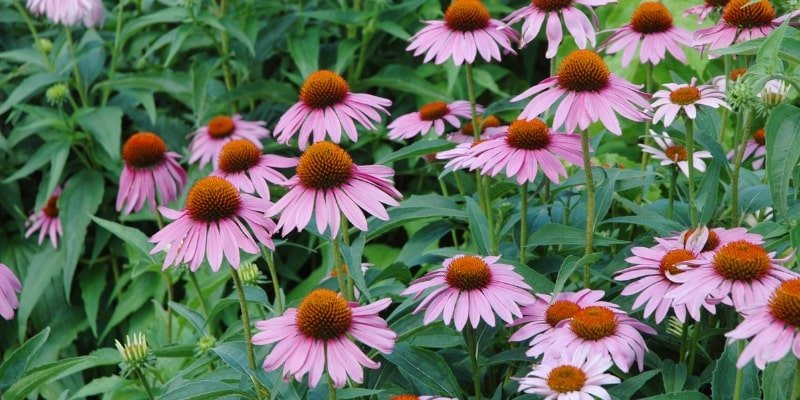
Scientific Name: Echinacea
Plant Type: Perennial
Plant Size: 2-3 feet tall
Sun Exposure: Part sun to full sun
Plant Zone: 3-9
Geographic Origin: North America
The coneflower has a unique shape that is similar to a cross between a daisy and a badminton shuttlecock. They feature petals that range in colour from bright pink to purple, encircling an orange cone-shaped centre that attracts pollinators from all directions.
They do well in open meadows growing wild or in well-manicured mixed gardens. When choosing the ideal spot for these gorgeous perennials in your garden, remember that they require full sun.
66. False Indigo

Scientific Name: Baptisia australis
Plant Type: Perennial
Plant Size: 4 feet tall
Sun Exposure: Partial shade to full sun
Plant Zone: 3-9
Geographic Origin: North America
Blue false indigo is another name for false indigo. You may be confident that the flowers you buy—as long as you buy Baptisia australis—will be purple, whether you go to the store or order seeds in search of purple flowers. Additionally, some baptisiat ypes have the potential to grow purple flowers.
67. Hardy Geranium
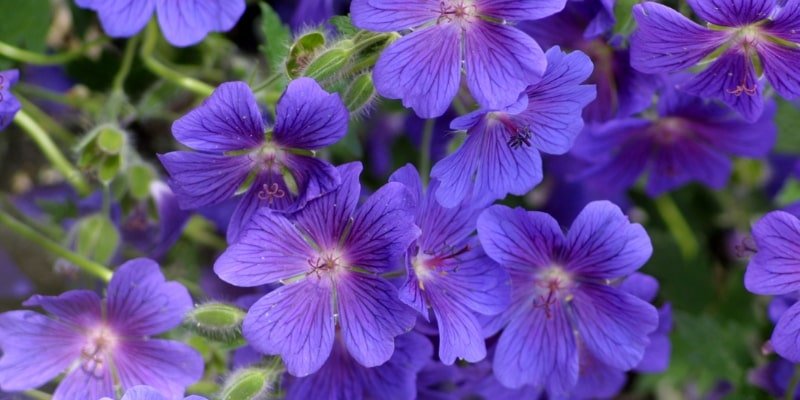
Scientific Name: Geranium bohemicum
Plant Type: Perennial/Annual/Biennial
Plant Size: 1-3 feet tall
Sun Exposure: Full sun to partial shade
Plant Zone: 10-11
Geographic Origin: Southern Africa
A subset of the approximately 400 species of flowering evergreen geraniums are hardy varieties. They have beautiful, symmetrical, papery five-petaled flowers that bloom all summer long. Although dark purple blooms are prevalent, they can also have red or pink flowers.
68. Hyacinth
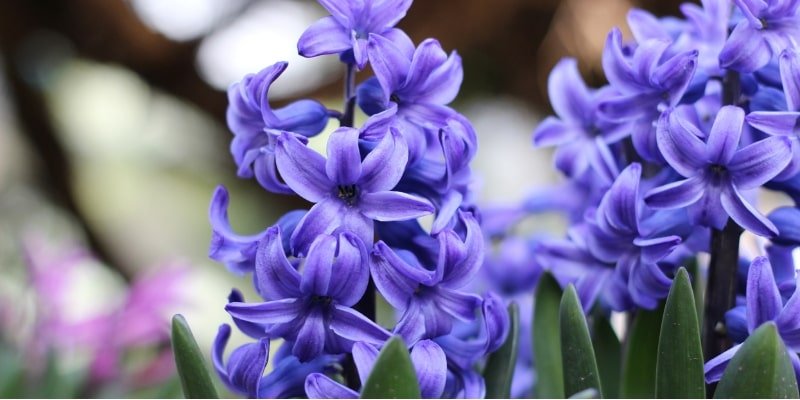
Scientific Name: Hyacinthus orientalis
Plant Type: Perennial
Plant Size: 6-8 inches tall
Sun Exposure: Indirect to full sun
Plant Zone: 3-9
Geographic Origin: Eastern Mediterranean
Every year, a prolonged stretch of cool weather is necessary for hyacinth bulbs to bloom.
Hyacinth must thus be planted in containers and brought inside during the summer into a cool garage or refrigerator if you do not receive roughly thirteen weeks of weather with 35 to 48-degree temps.
When cold enough weather occurs in the spring, they bear thick clusters of blue-to-purple blooms that burst in colour. They also have slender leaves. Among the more than 2,000 hyacinth cultivars is a brilliant purple variety called “Purple Sensation.”
69. Iris pumila

Scientific Name: Iris Pumila
Plant Type: Perennial
Plant Size: 2-3 feet tall
Sun Exposure: Part sun to full sun
Plant Zone: 3-9
Geographic Origin: Eastern, Southwestern North America
Iris pumila also referred to as the pygmy iris, is characterized by its deep purple blooms and light to lacy, blade-like green foliage.
The most common flower colours are white and purple, while others feature patterns in blue, white, cream, or other colours. They could be a naturally occurring cross between Iris Attica and Iris pseudopodia.
70. Lavender

Scientific Name: Lavandula
Plant Type: Perennial
Plant Size: 2-3 feet tall
Sun Exposure: Full sun
Plant Zone: 5-9
Geographic Origin: Europe
The famous herb lavender is known for its smell as well as its purple blossoms. Throughout the summer, the little flower clusters stand erect on spikes.
The leaf is grey-green and fragrant. Choose a location for your lavender plant that receives full sun and well-drained soil. A healthy growth environment requires very little maintenance from the plant.
71. Mountain Cornflower
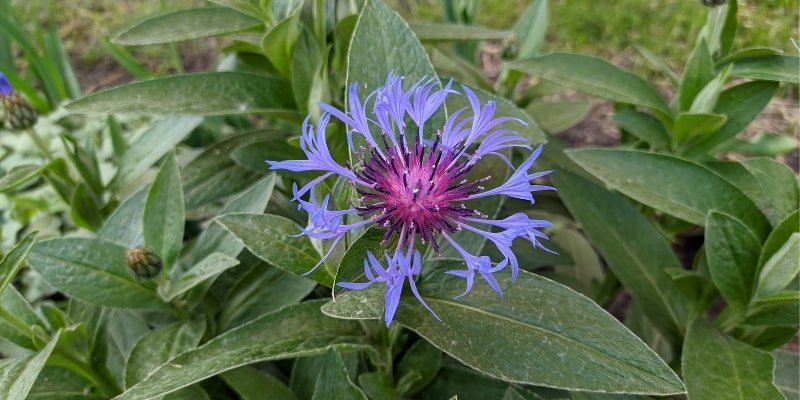 Scientific Name: Centaurea Montana
Scientific Name: Centaurea Montana
Plant Type: Perennial
Plant Size: 1-2 feet tall
Sun Exposure: Full sun
Plant Zone: 3-8
Geographic Origin: Europe
You may also refer to the mountain cornflower as a bachelor’s button or perennial cornflower. They resemble annual cornflowers and are clump-forming plants with sword-shaped leaves.
Once the buds open, they resemble tiny pineapples with centers of a darker purple colour and blue to-purple leaves.
Certain varieties have petals that are an intense shade of purple. Potted specimens of this plant often survive for over fifteen years, and it grows well both in a garden and a container.
72. Passion Flowers
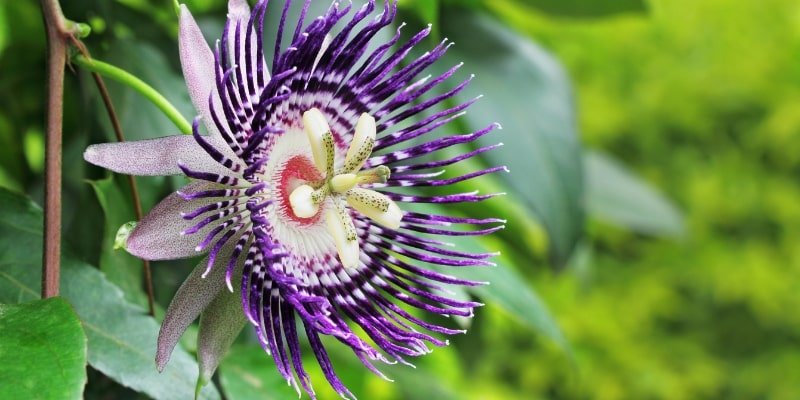
Scientific Name: Passiflora
Plant Type: Perennial
Plant Size: 6-30 feet tall
Sun Exposure: Full sun to partial shade
Plant Zone: 5-9
Geographic Origin: South and North America
Since ancient times, Native Americans have utilized passion flowers—sometimes spelled passionflowers—as medicinal remedies. Spanish explorers first brought passion flowers back to Europe in the 1500s.
Today, it is a joint dietary supplement and medical treatment for a number of diseases in Western culture.
The lengthy, tough vines of this plant are more vulnerable to harm from strong winds because they can grow quite long. You can add purple blooms to your garden by looking for Passiflora incarnata.
73. Lily Turf

Scientific Name: Liriope muscari
Plant Type: Perennial
Plant Size: 6-12 inches tall
Sun Exposure: Full sun
Plant Zone: 5-10
Geographic Origin: Eastern, Southwestern North America
Liriope leaves give your yard a pop of colour even when not in bloom because they stay lush and green throughout the year.
These hardy, short plants can aid in controlling erosion because of their robust root systems. The blade-like, possibly striped, yellow-tinged leaves resemble Grass.
The blossoms come in a variety of hues, usually ranging from white to purple and blue. Depending on the type, tiny, bell-shaped flowers can bloom from spring to autumn on the robust stalks that bear dense, tight spikes of them.
74. Melastoma
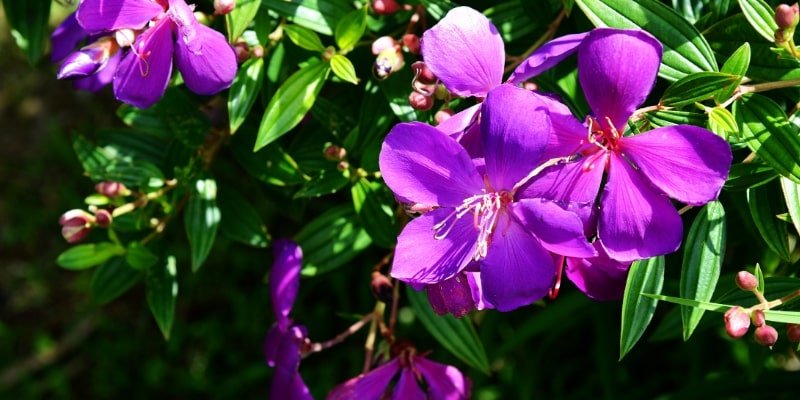
Scientific Name: Melastoma
Plant Type: Perennial
Plant Size: 1.5-30 feet tall
Sun Exposure: Full sun to partial shade
Plant Zone: 11
Geographic Origin: Southeast Asia, India, Japan, Australia
Typically, tropical habitats are home to the Melastoma genus. Their flowers are fuschia, purple, and pink, and they grow freely as shrubs and viny plants. With five petals and a papery feel, the blossoming blooms are relatively large.
Although species within the genus vary somewhat, warm, humid weather is necessary for the majority of melastoma variations.
Therefore, be ready to give this plant up to 23 inches of water each week. If allowed to spread out, they have a rapid rate of growth and can become invasive.
75. Black Adder Giant Hyssop
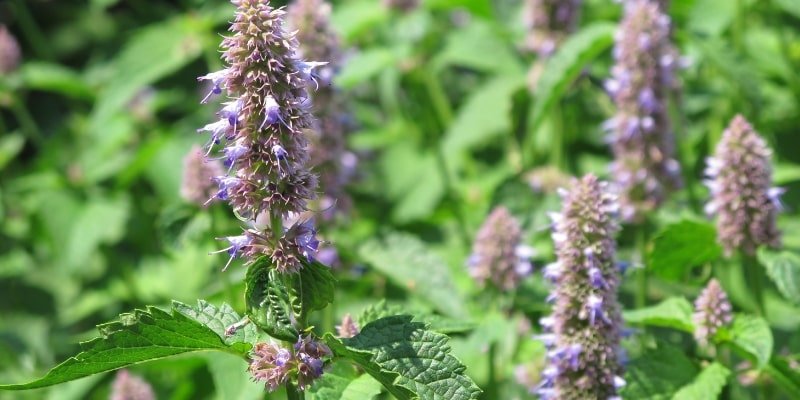
Scientific Name: Agastache Lamiaceae
Plant Type: Perennial
Plant Size: 2-3 feet tall
Sun Exposure: Full sun to partial shade
Plant Zone: 6-9
Geographic Origin: Western United States
“Black Adder” The hybrid of A. rugosa and A. foeniculum is known as the giant hyssop. Their flowers are thick, prickly, and quite plump.
The actual flowers are relatively tall, primarily purple, with some red and white undertones. Soils that are poorly draining and severely compacted do not suit them well. These vibrant flowers attract a lot of pollinators.
76. Moonflower

Scientific Name: Ipomoea turbinata
Plant Type: Annual
Plant Size: 1-3 feet tall
Sun Exposure: Partial sun to full sun
Plant Zone: 10-11
Geographic Origin: North America
Moonflower blossoms reveal their delicate, five-sided, purple-to-white flowers when they open at night. The petals have smooth edges and are nearly squared off.
These vines can grow to be pretty vigorous perennials in warmer climates. In cooler climes, they can thrive as annuals as well, although they won’t grow as high or far.
These tropical morning glories can grow to be pretty long when given space and heat, but they don’t perform well when vying for territory. Additionally, they can grow in practically any soil as long as it drains properly.
77. Pasque Flower

Scientific Name: Pulsatilla
Plant Type: Perennial
Plant Size: 5-8 inches tall
Sun Exposure: Full sun to partial shade
Plant Zone: 3-9
Geographic Origin: Asia, Europe, North America
Easter flower is another name for this herbaceous perennial. It’s coloured azure and reddish purple, and it looks like a little tulip. Since it appears early in the spring, it is a welcome sign of the coming season. These little, brightly colored flowers work well in rock gardens and as borders.
78. Peony
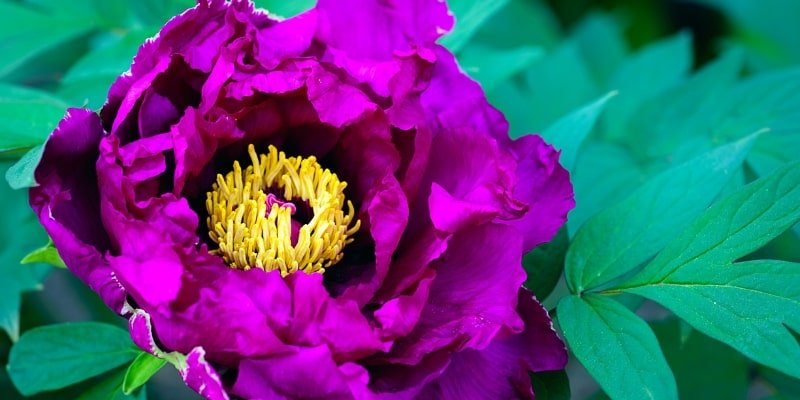
Scientific Name: Paeonia
Plant Type: Perennial
Plant Size: 1-4 feet tall
Sun Exposure: Full sun to partial shade
Plant Zone: 3-8
Geographic Origin: China, Europe
Peonies often bloom around the middle to end of April. Their blossoms are frequently rather large and might have as many as twenty petals or as little as seven.
They are highly aromatic and have a deep cup encircled by petals. Gorgeous purple blossoms can be found on particular peonies.
In addition, there are peony variants that resemble shrubs, and more significant forms are known as tree peonies.
79. Bee Orchid

Scientific Name: Ophrys Apifera
Plant Type: Perennial
Plant Size: 2-3 feet tall
Sun Exposure: Shade, light shade
Plant Zone: 6-9
Geographic Origin: Southern Europe, North Africa
One of the most unusual flowers in the plant kingdom is that of the bee orchid. Every violet blossom has four petals. Three of them have a floral, purple, and triangular shape.
With its head buried in the center of the flower, the fat fourth petal faces downward and has a distinct resemblance to a bumblebee.
For this particular kind of orchid, rocky outcrops and containers work best. The soil should be neutral, well-draining, and consistently humid.
80. Rose of Sharon

Scientific Name: Hibiscus
Plant Type: Perennial shrub
Plant Size: 8-12 feet tall
Sun Exposure: Full sun to partial shade
Plant Zone: 5-8
Geographic Origin: Asia
The specific colour of the flowers on this species of hibiscus varies; however, they may be purple in colour. A conspicuous tubular stamen is surrounded by five petals that are gently ruffled. They grow up to two feet a year, are easy to grow, and are well-liked by pollinators.
They are also tolerant of less-than-perfect conditions. In order to control growth and give the plant structure, they usually require periodic trimming.
81. Anemone
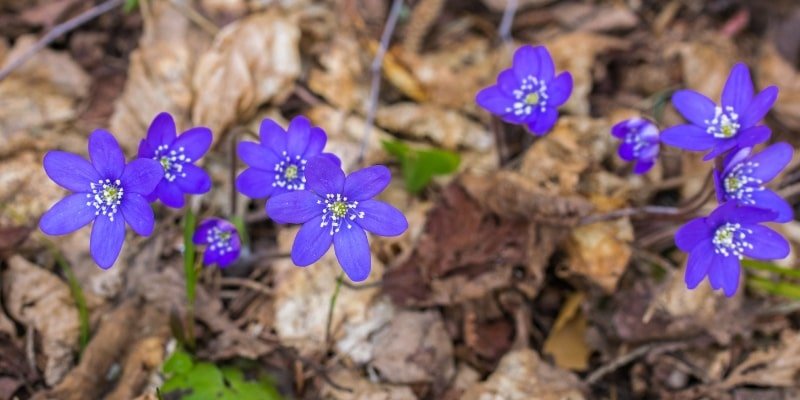
Scientific Name: Anemone coronaria
Plant Type: Herbaceous Perennial
Plant Size: 12 inches
Sun Exposure: Partial to full shade
Plant Zone: 5-8
Geographic Origin: Europe and the America
The velvety, thick leaves of anemones are typically grouped into three groups. A solitary, tiny bloom appears at the end of a delicate, thin stem that is borne on three leaves.
The first warm rains following a chilly winter usually correspond with the onset of spring blossoms.
These are hardy wildflowers that seed and resprout every season if left untouched. They are drought-tolerant, reasonably simple to grow, and available in various hues, including blue, pink, white, and purple, in varied tones.
82. Balloon Flower

Scientific Name: Platycodon grandiflorus
Plant Type: Perennial
Plant Size: 2-2.5 feet tall
Sun Exposure: Full sun to partial shade
Plant Zone: 3-8
Geographic Origin: Japan, China
The balloon flower gets its name from its unusual blooms, which appear balloon-like. The buds of balloon flowers open into star-shaped blossoms as they grow. In North America, the plants bloom in the summer, from around June to August, and grow in broad clumps.
There are numerous varieties, each with a unique hue; the most popular is called “Fuji,” yet they are rarely purple. However, try to find cultivars of “Double Blue,” “Astra Double Blue,” and “Apoyama” if you’re looking for purple blossoms.
83. Dendrobium Orchid

Scientific Name: Dendrobium
Plant Type: Perennial
Plant Size: 6 inches
Sun Exposure: Partial sun
Plant Zone: 9-12
Geographic Origin: Asia
Dendrobium is a flowering herb that grows well on other plants; there are more than 1,800 variants of this plant. Their roots help the plant expand throughout a garden by adhering to tree bark, rocks, and stems.
Certain types always have purple flowers that emerge from deep green foliage. They do nicely in rocky tropical gardens or containers with good drainage.
84. Italian Aster
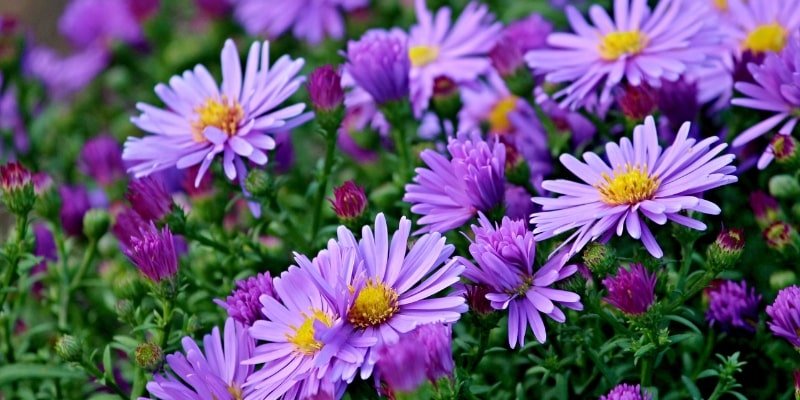
Scientific Name: Aster amellus
Plant Type: Perennial
Plant Size: 8-18 inches tall
Sun Exposure: Full sun
Plant Zone: 3-9
Geographic Origin: Europe
Italian asters have tiny flowers with many thin purple petals and a vivid orange center. They resemble a hybrid of a white-petaled daisy and Echinacea, and they are pretty simple to grow in most home gardens.
Deadheading wasted blooms will, like with many other flowering plants, enhance the chance of more blooms. This low-maintenance, tiny plant may quickly spread, producing a carpet of purple flowers in your yard. If uncontrolled, their easy spread could potentially be a drawback.
85. Lily of the Incas
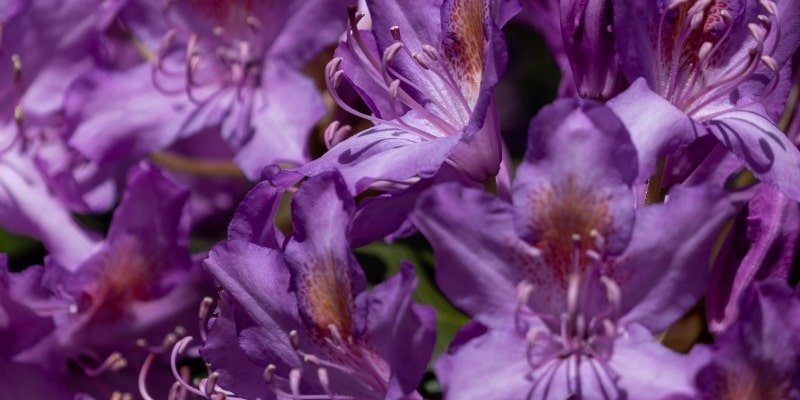 Scientific Name: Alstroemeria
Scientific Name: Alstroemeria
Plant Type: Perennial
Plant Size: 1-4 feet tall
Sun Exposure: Part sun to full sun
Plant Zone: 8-10
Geographic Origin: South America
The lily of the Incas is not a real lily. They do, however, have similar tuber-grown blossoms with vibrant colours. There are several distinct varieties of Inca lilies, and not all have purple buds. Pay attention to the purple flowers of the “Annica” and “Azula” varieties.
Given enough warmth and moisture, these plants may be able to blossom all year. It is important to remember that they have an intense thirst and can consume up to 12 inches of water every week.
86. Lungwort
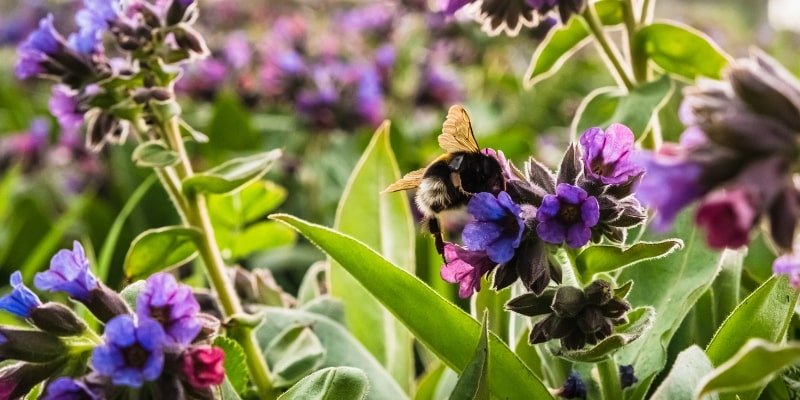
Scientific Name: Pulmonaria officinalis
Plant Type: Perennial
Plant Size: Up to ten inches tall
Sun Exposure: Partial shade to full sun
Plant Zone: 4-8
Geographic Origin: Europe and Asia
Lungwort is a very short forest plant with tiny, delicate flowers that are frequently purple and grow at the ends of slender, woody stems. The name comes from how the plant’s speckled leaves vaguely resemble human lungs. The flowers’ deep bell has a nearly funnel-like form.
Variegated patterns on the leaves and flowers can enhance their striking appearance. These are frequently used along garden borders because they are typically relatively short.
87. Morning Glory

Scientific Name: Ipomoea purpurea
Plant Type: Annual
Plant Size: Up to 15 feet tall
Sun Exposure: Full sun
Plant Zone: 3-10
Geographic Origin: Mexico, Central America
Gardeners often utilize morning glory plants around fences, walls, and arbors because of their vigorous climbing habit.
Growing in containers is an option if you fear they may overtake your garden when they bloom, which occurs from early summer to fall and features large, funnel-shaped purple flowers.
Although purple is a popular hue, the blossoms can also be vivid pink, crimson, or white. Hummingbirds and butterflies, among other pollinators, are drawn to them.
88. Moss Verbena
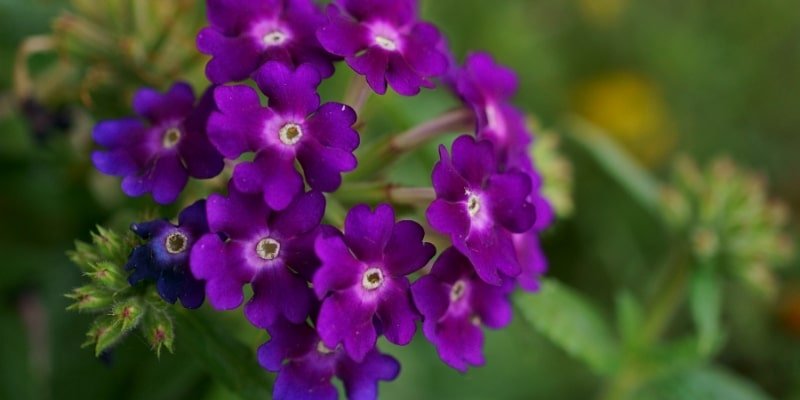
Scientific Name: Verbena aristigera
Plant Type: Perennial
Plant Size: 8 inches to 1 foot tall
Sun Exposure: Full sun
Plant Zone: 8-10
Geographic Origin: South America
Moss verbena produces eye-catching blooms of star-shaped flowers in the springtime; it is wider than it is tall. Then, as the temperature drops, the violet, lilac, and purple flowers bloom again.
Despite being low-maintenance, they prefer soil that drains well. They grow well in pots or many types of landscape environments.
89. Sea Holly
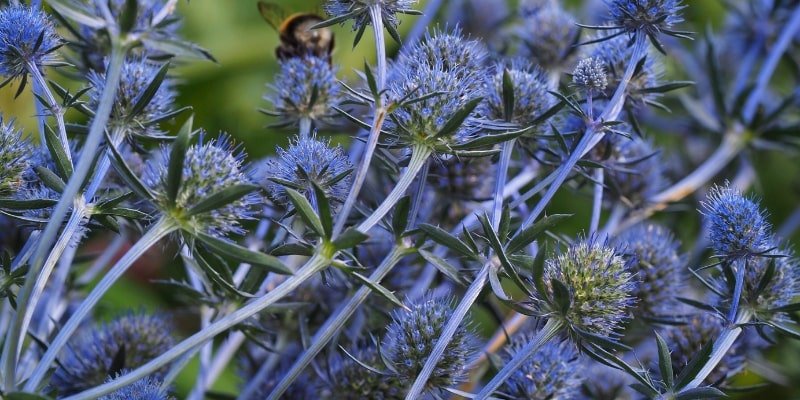
Scientific Name: Eryngium planum
Plant Type: Perennial
Plant Size: 2-3 feet tall
Sun Exposure: Part sun to full sun
Plant Zone: 5-9
Geographic Origin: Southeastern Europe, Central Asia
Sea holly blooms are tiny and resemble cotton swabs. At the end of somewhat short stalks, they develop into puffy clusters of three flowers. A single plant can produce many purple flowers, which emerge in the middle of the summer.
These hardy plants can thrive in unsuitable gardening locations for other types of flowers.
90. Tropical Hibiscus
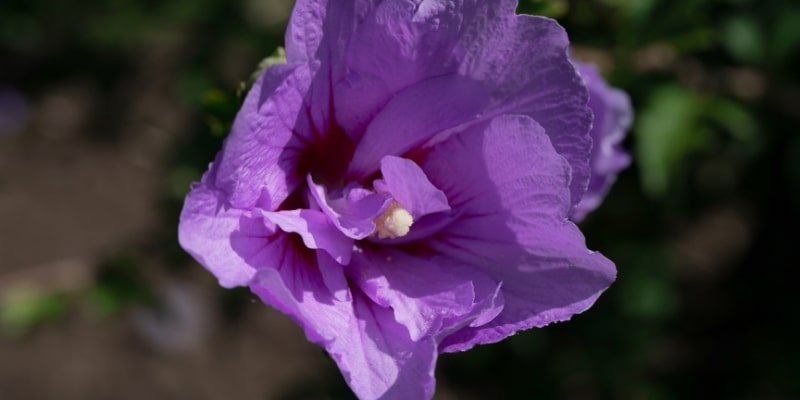
Scientific Name: Hibiscus rosa-sinensis
Plant Type: Evergreen shrub
Plant Size: 4-15 feet tall
Sun Exposure: Full sun to partial shade
Plant Zone: 9-11
Geographic Origin: Asia
Tropical hibiscus plants are almost always in flower. However, their huge, ruffled flowers are only present for a single day before they fade or are carried off by the wind. They have noticeable stamens, and when the plant has plenty of sunshine and doesn’t mind being cold, it produces more blooms.
91. Pigeon Berry
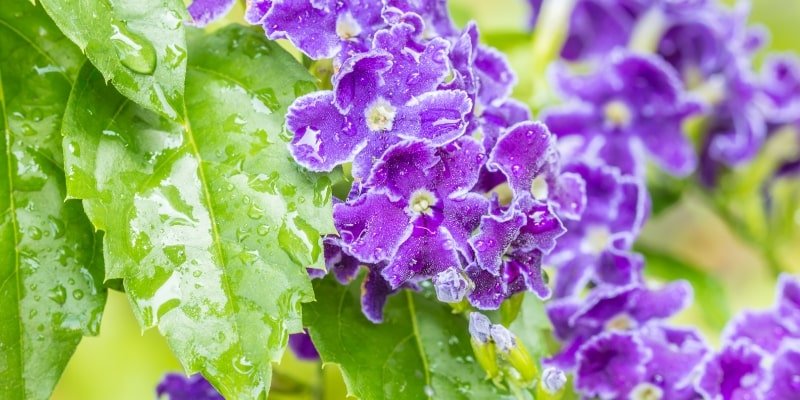
Scientific Name: Durante erecta
Plant Type: Perennial
Plant Size: 4-6 feet tall
Sun Exposure: Full sun to partial shade
Plant Zone: 9-11
Geographic Origin: Florida, South America
The tube-shaped blossoms of these beautiful, broadleaf evergreens are frequently violet or purple.
Moreover, they can be white or blue. Occasionally, white borders form around the periphery of small, darkly colored blooms, giving them an intriguing frill. If consumed, it can prove to be fatal.
92. Petunia

Scientific Name: Petunia
Plant Type: Annual
Plant Size: 6 inches to 1.5 feet tall
Sun Exposure: Full sun to partial shade
Plant Zone: 10-11
Geographic Origin: South America
Petunias come in a wide range of hybrid types, with the exception of brown and black, and can have flowers in nearly every colour.
While some varieties are solid, others feature variegated colours. The fragrant, trumpet-shaped flowers bloom from mid-spring to late summer and continue to do so until the first frost.
93. Calla Lily
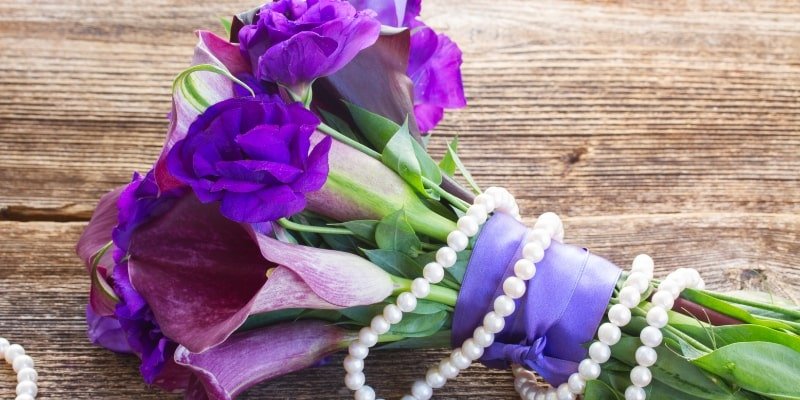
Scientific Name: Zantedeschia
Plant Type: Perennial
Plant Size: 2-8 feet tall
Sun Exposure: Partial sun to full sun
Plant Zone: 5-11
Geographic Origin: Southern Africa
There are eight species of flowering plants in this genus. They generate artificial blooms that resemble lilies, even though none of them are real lilies, and they don’t bloom in the conventional sense.
Midsummer is when these brightly coloured, funnel-shaped pseudodanthia first develop on the shrub and continue until late autumn.
Another name for calla lilies is arum lilies. Native to Southern Africa, this purple flowering shrub also appears in different hues.
94. Blackcurrant Swirl Moonflower

Scientific Name: Datura metel
Plant Type: Perennial
Plant Size: 2-3 feet tall
Sun Exposure: Part sun to full sun
Plant Zone: 3-9
Geographic Origin: Eastern, Southwestern North America
The massive blooms on this shrub-like plant are most noticeable in the evening. This specific Datura type features trumpet-shaped flowers with a deep purple colour and white highlights frequently on the tips.
These deadly plants have been used for millennia for a variety of purposes, including weapons, medicines, and spiritual support. In addition to their hallucinogenic qualities, they add color and vibrancy to your garden.
95. Hellebore

Scientific Name: Helleborus
Plant Type: Perennial
Plant Size: 2 feet tall
Sun Exposure: Full Sun to Partial shade
Plant Zone: 3-9
Geographic Origin: Middle East
Intense summer shade and lots of winter sunshine are ideal growing conditions for hellebores. Thus, the best spot to shade you from the heat is under a deciduous tree that loses its leaves in the autumn. In rare cases, they even blossom in late winter or very early spring.
Though they have been hybridized and are available in various colours, like purple, hellebores are naturally multi-coloured plants. Dark blue, purple, and nearly black blossoms adorn the ‘Phillip Ballard hellebore, for example.
96. Lupine
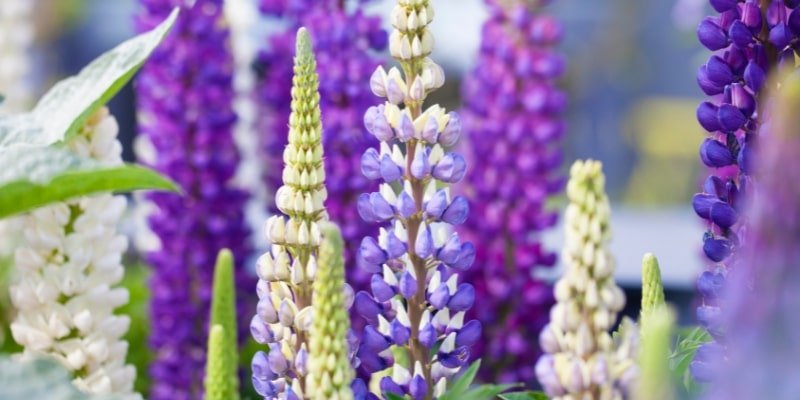
Scientific Name: Lupinus
Plant Type: Perennial
Plant Size: 3-4 feet tall
Sun Exposure: Full sun to partial shade
Plant Zone: 4-8
Geographic Origin: Mostly North America
Growing wild, lupine loves broad, windy meadows. Numerous hundreds of species bloom in every shade of purple, among other colours.
Because it was thought that lupines consumed a lot of the nutrients in their soil, much like predators, the term “wolf” was derived from the Latin word for wolf.
This wildflower develops swiftly to a tall, conical spire; variations are annual and perennial. Purple flowers are expected.
97. Small Scabious
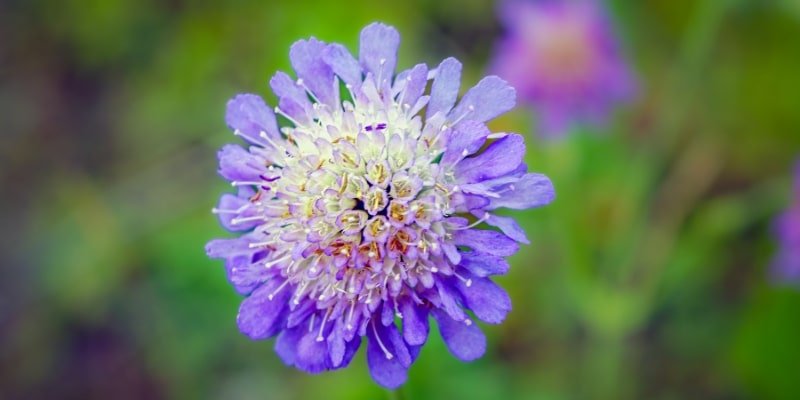
Scientific Name: Scabiosa columbaria
Plant Type: Perennial
Plant Size: 1-3 feet tall
Sun Exposure: Full sun
Plant Zone: 3-6
Geographic Origin: Europe, Africa, western Asia
The branching leaves of this Scabiosa species yield pale purple blooms. Summer is when the flowers first appear, and they may continue to bloom well into autumn. But after they blossom, the blooms usually don’t stay around long.
98. Clematis

Scientific Name: Clematis
Plant Type: Perennial/Biennial
Plant Size: 3-12 feet tall
Sun Exposure: Full sun
Plant Zone: 4-9
Geographic Origin: North America
Clematis is a woody, viney climbing plant with more than 300 cultivars that can feature purple flowers. The star-shaped, six-petaled flowers have a white centre and can have nearly solid colours or varied patterns on them.
Their flower colours range from dark inky purple to much lighter tints like lilac, lavender, or violet. They may have white, pink, or red blooms. If given unrestrained growth, clematis grows swiftly and can quickly take over a whole region.
99. Sea Thistle

Scientific Name: Cirsium japonicum
Plant Type: Perennial
Plant Size: 1-3 feet tall
Sun Exposure: Full sun
Plant Zone: 3-9
Geographic Origin: Eastern Asia
Shade is something that sea thistle cannot tolerate at all. Plant it in a sunny, well-kept garden, and its tuberous roots will yield a little cluster of leaves.
It then has cup-shaped flowers with spiky purple stamens at the top in late July. Depending on where you live, sea thistles may or may not be regarded as weeds.

